to start off a thread with actually useful information, here is how to reduce your Vectrix' power consumption by at least 25%....
The problem is that the Vectrix continues to consume power after the charge process is apparently finished, when the lights and fans are out and all is dark and quiet....
On the Australian 240V grid this continuing power use amounts to about 114watt for as long as the Vectrix remains plugged in. This energy goes into heating up the charger - you can have a feel of it by putting your hand through between the front fork; it's on the opposite side to the glove box. The charger is initially cool or warm whilst the charging process is running; once charging is finished the charger gradually heats up until it is very hot a few hours later - it can get too hot to touch, so be careful! It might also be a smart idea to unplug the Vectrix before sticking your hand in there, I am not sure if there is any potential for touching any "live" parts there.
The immediate solution is to unplug the Vectrix after charging, or use a timer.
This might also reduce the exposure to damage from power surges whilst connected.
The estimate of 25% inefficiency is based on these observations/measurements:
a)Daily 80% discharge by driving 40km (at the same speed as the other traffic, ie 20km at 70-80km/h, the rest at 60km/h stop-and-go) and daily full recharge - requiring about 4kWh.
b)Vectrix remaining plugged in from end of charge until the next morning for about 12h: requiring about 1.37kWh (which are wasted as heat).
The inefficiencies (losses) would of course be much larger if the Vectrix remains plugged in for longer (weekends etc) or if the discharge between recharging cycles is lower.
A proper solution would be for the manufacturer to add an electronic device that completely shuts down the charger once the battery is full, enabling next to zero standby power consumption.
Ideally this device would also have the ability to restart the charging process periodically if the Vectrix is left parked for prolonged periods (like during holidays) to prevent slow loss of charge.
Mik
This information may be used entirely at your own risk.
The Suprbike is just a model of something that does not exist, at all. The idea for Vectrix was to see if the public liked the way the bike looked, and then they were going to try to manufacture it and sell it as a limited edition for $60,000. Again, this bike does not exist, it’s just a model. This was a project started by Carlo Diabigio, former Ducati Director, but Vectrix has since fired Carlo and replaced him with some person who is lost in this 2 wheel world. The Superbike won’t be built, and is another example how Vectrix loves to sell the HYPE, not the real thing!
Vectrix, is a joke of a company along with their bike. Truth: there 2 wheeler can only go a range of 30 to maybe 38 miles total! The bike weighs 525 lbs., and they are supposed to switch to Lithium batteries in 9 months, late 2008; so why waste you money now? $12,000 +, this is way too much for a scooter! Also, they have SEVERE software issues that give false readings for estimated range, after cruising along for 10 miles or so, it immediately drops down to zero miles range, and no battery left!!
You know why they have home delivery service? Because Vectrix bike wont go far enough to get to your home and they are afraid that it will break down on the way home, too!
The company is run by wanna be that do not understand the real world demands of electric. Their arrogant group back in Rhode Island are nothing but a bunch of former yachts men, playing with electrical toys they do not know how to manufacturer.
Oh, the Vectrix bike is made in Poland! Why not the good old USA??
Advice: stay away from Vectrix, they are selling the hype. The bike looks nice on the outside, but it doesn’t hold up in the real world!
I had kinda feared that ever since they didn't bring it to EVS-23. *sigh*
I loved the way that bike looked. That's my all-time favorite-looking bike. I swear, if I ever get the money, I'll make something that looks just like that.
The author of this post isn't responsible for any injury, disability or dismemberment, death, financial loss, illness, addiction, hereditary disease, or any other undesirable consequence or general misfortune resulting from use of the "information" contai
Please keep this Forum for Vectrix Review, Report, Experience
Dear pointman39 and LinkOfHyrule,
It can of course be difficult to distinguish between advertising hype and independent reports.
That is exactly why I would like to keep the topic of this forum strictly limited to accounts of actual first hand, real world experience, tests, observations and measurements by Vectrix Maxi Scooter owners or riders.
Whilst your points are well worth considering and debating, and might all be accurate, it is of course not apparent to me what your level of expertise is regarding the various subjects which you mention.
You might have formed your interpretations, opinions and advice on thorough assessment of all the available facts, and I will follow the continuation of this debate in the "Vectrix unveiled Electric Superbike and Trike Concept" Forum with much interest.
I am glad that you (pointman39) have posted the exactly same text in that Forum, because it will allow everyone to continue this important discussion there, in a more appropriate Forum.
.
This way we all have a chance to collect and access first hand, real world performance information about the Vectrix Maxi Scooter in one location.
This information can then be used by you and others to back up, make up or revise your opinions, and you can discuss them in the most appropriate forum.
That way everyone wins!
Cheers,
Mr Mik
This information may be used entirely at your own risk.
Hi,
having had the Vectrix Maxi for two weeks now, I decided to do a Range Test at 40km/h.
I would have done this test earlier, but the Vectrix was off the road for a few days due to a broken tail light/brake light. The dealer replaced it (for free) by mailing it to me within two working days despite the seasonal troublesome loads of greeting cards and presents in the mail...
So I had the pleasure to take the rear end of the Vectrix apart in order to diagnose the problem and to replace the tail light; all part of owning a Vectrix which is probably the one furthest from the next dealer - 2000km to be quite exact, Melbourne to Gold Coast, Australia. (Correct me on this one if anyone is further away - maybe in Western Australia?)
It takes the removal of a minimum of 25 screws to replace the tail light and about one hour until the old one is out, and another hour until the new one is in and the Vectrix is in one piece again. No special tools or abilities required. Just make sure you keep all the screws in order so that there are no leftovers ;-).
Dont worry, only the two top rows of screws are from the Vectrix!
All the parts that I came across in the process appear to be well made and fit together well. It would however be an expensive job to "change a bulb" once the warranty period is over, particularly if you pay a mechanic to do the labor for you. The rear light/brake light is a semi-sealed unit with 13 LED's and a circuit board, looks expensive.
Noteworthy is that there was no warning displayed on the controls indicating that the rear light/brake light was malfunctioning; but disconnecting the number plate illumination connector causes the "position lamp telltale" to blink, and disconnecting the indicator lights causes the indicator telltales to illuminate constantly instead of blinking. So, check that your Vectrix' rear/brake light works every now and then...
Back to the real world test ride:
I chose a stretch of road without traffic lights and a time with very little traffic - Dec 25th, 2007.
You get a better version of the pictures below if you click on the link above and then view it in Google earth.
.
The road winds gently uphill with a few shorter downhill stretches, probably rising about 200-300m from the start to the turnaround point on the border to NSW.
The weather was 24deg C, cloudy, a bit of drizzle at times, light to moderate wind from the south and it did not change during the test ride.
So I was starting off going uphill and against the wind, assuming that I should easily make it back to the starting point if I turned around once the battery was half empty.
I am 187cm tall, and including protective gear and all the various Gizmos I usually drag along with me, I weigh about 100kg.
The Vectrix was fully charged, then brought to the starting point (a good spot to park a trailer) in order to avoid any potential stop-and-go traffic effects on its range.
Instrument panel at the start of the test drive:
On the left: Time (13:19); Estimated remaining Range (82km); and km traveled (0).
In the middle: Total km the Vectrix has done (415.6km).
On the right: Battery charge indicator.
.
.
I kept the speed constant at 40km/h as good as I could, using the regen braking on all downhill parts of the trip.
I only stopped a few times to take photos of the cockpit; never used the disk brakes; and was as gentle on the throttle as possible.
I basically turned myself into a traffic hazard - figuring I might get away with it on Dec 25th!
The return trip is 62km long - how far do you think my Vectrix went?
.
.
Here is the instrument panel at 20.4km (uphill against the wind):
.
61km range left
20.4km traveled
13/17 bars left on the battery indicator.
.
. Added Dec 26th, 2108h EAST:
Here is the instrument panel after 30km:
.
.
I'm sorry that it is just about impossible to read the displays on some of the photos I am showing here. It's due to the reduced picture resolution which the forum allows to upload (and my very average camera and photographic abilities....) What you would see on the original picture is:
Time: 14:02
EST RANGE: 47km
30.0 TRIP A
445.6km total
10/17 left in battery.
.
Added on Dec 26th, 2007, 2120h AEST:
Well, I made it to the turnaround point on the test course!
.
.
Instrument panel at this point:
. Time: 14:06
Est Range: 44km
31.4 Trip A
447.0km total
9/17 remaining in battery.
.
Added on Dec 26th, 2007, 2136 AEST:
In case you wonder why I add bits at a time: It's so I don't lose hours of work when my computer plays up or if I hit the wrong button - I made that mistake yesterday :-(
Instrument panel 40.9km into the test drive:
.
. Time 14:22
EST RANGE: 41km
40.9 TRIP A
456.5km total
8/17 battery charge left.
Whats your guess - how much further will it go?
.
. Added Dec 26th, 2007 at about 2220h AEST:
.
Instrument panel 50.3km into the test drive:
.
TIME: 14:37
EST RANGE: 33km
50.3km TRIP A
465.9km total
7/17 left in battery.
. Added Dec 26th, 2007, about 2230 AEST:
.
Instrument panel 60km into the test drive:
. TIME: 14:53
EST RANGE: 23km
60.0km Trip A
475.6km total
5/17 left in battery.
Still voluntarily crawling along at 40km/h....
Will it last much longer?
.
.
Added Dec 26th, 2007, about 2245 AEST:
.
.
I, and my Vectrix, made it back to the starting point! That kinda helps :-)
.
Instrument panel at 62.9km, back at the starting point:
. TIME: 14:59
EST RANGE: 20km
62.9km TRIP A
478.5km total
4/17 left in battery.
Having made it back to the starting point I decided to start again, following a similar approach as before:
--Go at a speed of 40km/h no matter what, heading south and uphill into the wind...
and
--Turn back once half the range is gone - ie once I've traveled 10km or once the EST RANGE drops to 10km, whatever comes first.
.
How much further do you think will this Vectrix go??
Added Dec 26th, 2007, 2322h AEST:
Here is another view of the test course to help you make a guess:
.
.
Added Dec 27th, 2007, 1020h AEST:
.
I had a few minutes break before I headed off again, here is the instrument panel just before starting again:
.
Time: 15:01
EST RANGE 20km
62.9km Trip A
478.5km total
4/17 left in battery.
.
After traveling at 40km/h for 2.1km the EST RANGE indicator suddenly dropped to zero and the battery indicator did the same. It happened on one of the steeper uphill stretches.
The instrument panel at this point:
Time: 15:06
EST RANGE: 0km
65.0km TRIP A
480.6km total
0/17 Battery left.
.
More later.
.
Cheers,
Mr Mik
This information may be used entirely at your own risk.
Re: Vectrix Test Ride in the Real World at 40km/h - 2nd part
Thanks for your kind comments, Ben!
You replied to my report whilst I was typing away completing the last part of it. Now I cannot add the already typed rest to the above report.
I believe I have figured out how to compose a lengthy entry and enter it in one hit onto the website, and hope next time this will not be an issue.
So here is the last part of the report above:
I had a few minutes break before I headed off again, here is the instrument panel just before starting again:
.
Time: 15:01
EST RANGE 20km
62.9km Trip A
478.5km total
4/17 left in battery.
.
After traveling at 40km/h for 2.1km the EST RANGE indicator suddenly dropped to zero and the battery indicator did the same. It happened on one of the uphill stretches.
The instrument panel at this point:
Time: 15:06
EST RANGE: 0km
65.0km TRIP A
480.6km total
0/17 Battery left.
. Added on Dec 27th, 2007, 2300 AEST:
.
So, of course, I turned around immediately and headed back to the starting point.
I drove very slowly and my Vectrix made it back to the starting point by itself.
Instrument panel at the end of the Range Test Drive:
TIME: 1513
EST RANGE: 0km
67.1km Trip A
482.7km total.
0/17 battery left.
-- traveling at 40km/h is not a very safe option - any bike I would consider riding regularly needs to be able to flow with the traffic and have some reserve to accelerate out of trouble.
-- the degree of roughness of the road surface might have an impact; it is certainly an issue when pedaling bicycles - I always try to stay on a smooth patch when pedaling, and the relatively rough bitumen surface on the test road might have made a difference.
-- the increased power consumption due to the drag increase in headwind might not be fully compensated for by the reduction in drag on the way back. A perfectly straight and flat test course with a smooth surface and no wind would be needed - any Vectrix owners near the Nullarbor yet?
-- increased power consumption during uphill parts of the test road will only be partially recovered during downhill parts. I have attached an altimeter to the instrument panel to document the elevation better during future tests.
-- the Vectrix is anything but silent at 40km/h - it has a whining sound much like the gearbox of a car going fast in reverse gear. It is loudest between 30-45km/h, and is not audible to me at all somewhere above 55-60km/h. I am not sure if the noise is reduced at higher speeds or if all the wind noise just covers it up.
.
And last but not least the big question to you people out there riding all sorts of electric vehicles: Is there any electric motorbike or scooter available for immediate purchase that could replicate or beat this real world test result of my Vectrix?
Please respond to this report if you regularly ride an electric bike that you believe would manage to go a similar or greater distance on the described test road.
And please report your all-time highest range result if you ride a Vectrix, so we can work out if my Vectrix is showing typical performance or is an "outlier".
.
Thanks for reading my report, hope it is helpful in some way.
.
Coming up next: Vectrix Real World Top Speed Test.
.
Cheers,
Mr Mik
This information may be used entirely at your own risk.
Another thing that may explain the missing 40km : the batteries are not trained enough.
After several discharges at 100% , you should observe an increased range.
Re: Vectrix Test Ride in the Real World at 40km/h - 2nd part
Please respond to this report if you regularly ride an electric bike that you believe would manage to go a similar or greater distance on the described test road.
Yes, my XM-2000 would match this range with fresh batteries. In stock form out of the box I'm confident that my XM2K would match if not exceed that. I never did a low speed range test. However, at 40mph (65kph) it had a range of 25 miles (40km). I regularly commuted 24 miles a day at 40+mph, (that's 12 miles with a charge at work). Now there's snow on the ground and I'm back to my gas car.
I paid $1500 USD for my XM2K new. They then raised the price to $2000 USD. Unfortunately the batteries supplied are, to put it bluntly, CRAP - and now have about 10 mile range at 40+mph. Also, the wiring is marginal - the wiring is too skinny creating a large resistance drop. If one replaced the wiring (usatracy has done this) and upgraded to C-LiFePO4 batteries then I believe I would be able to handily beat the Vectrix in range tests. Both of these upgrades could be done and still come in at around 1/3rd of the $12,000 USD price of the Vectrix.
To be sure the Vectrix is a much higher quality bike. But, alas, to me it seems overpriced for what it delivers. However, seeing as they designed an electric bike from the ground up I can understand the price tag.
BTW, the XM-2000s are now sold out and are rumored to be replaced with a higher power, larger version in the spring.
Some questions for you:
1) Do you know what the specifications of the batteries in the Vectrix are?
2) Do you know what depth of discharge they run the batteries down to when the gauge reads zero?
3) Do you know how well the stock charger works?
A lot of us have learned the hard way to be wary of how the batteries and chargers are configured. For example on the XM2K "empty" is at 10.5V per battery - this gives a nice range when new but is too harsh on the batteries and greatly reduces their cycle life. Also, the batteries provided were "energy" batteries (thin plates, higher Ah's at 1C discharge rates) rather than "power" batteries (thicker plates, lower Ah's but longer life for high C discharge rates).
Good luck with your Vectrix - I look forward to reading more tests.
John H.Founder of Current Motor Company - opinions on this site belong to me; not to my employer Remember: " 'lectric for local. diesel for distance" - JTH, Amp Bros || "No Gas.
I am not keen to take photos whilst riding, you just have to trust me on the speed reports.
.
I assume the speed as indicated by the instrument panel of the Vectrix is correct; it appears to be correct when I compare it to the speed of the other traffic.
. The test course is a stretch of the M1, click the link below to see the map:
Viewing it in Google Earth gives you an even better idea of the terrain.
.
Below is a picture of the Test Course 2 viewed as if from the starting position; the terrain elevation is exaggerated x2 to make the problem more obvious:
As you can see, the difficulty is that you need to merge with traffic going at 100km/h, starting from a standstill at the intersection. And it's all going uphill quite a bit.
Then you stay on the M1 for a few hundred meters, going down the hill on the other side, cross over the M1 and merge with the M1 traffic again; at that point the terrain is almost flat, but the speed limit is 110km/h.
Then the speed limit drops to 100km/h as you approach the hilltop; continue back over the hill and off the highway, and that's the end of the test run.
It's maybe about 10km on the M1, but I did not take much note of it, it does not matter for this test setting; this one is just about top speed and acceleration.
.
So, how did it go?
The Vectrix accelerated onto the highway as if there was no hill; accelerating quickly to 102.5km/h and then suddenly the acceleration stops; merging was easy.
During merging the second time, into 110km/h traffic, the Vectrix also went 102.5km/h, although there is no climb. A speeding truck had to slow down behind me. It would be nice to be able to override the Vectrix' speed limitation on that particular on-ramp!
Here is the instrument panel after stopping to buy some velcro for attaching the altimeter to the instrument panel (to monitor elevation in future tests):
23.8km traveled, including the test course Nr 2, the rest of it also in a very throttle happy fashion at the speed limit, mostly 70 and 80km/h.
EST RANGE: 45km
Total km: 563.9
9/17 left in battery.
This is the instrument panel at the end of the trip:
EST RANGE 10km
Trip distance: 42.5km
Total 582.6km
2/17 left in battery.
Almost the entire trip was at speeds of 70km/h or above.
The last 2 km or so were at reduced speed: 60, 40, 30km/h due to lack of power.
The range indicator did not suddenly drop to zero this time, which might be due to a change in my behaviour:
I might have figured out what causes the sudden drop to zero EST RANGE and battery power, which I observed repeatedly before:
Once power drops and speed reduces, particularly when going uphill, it is tempting to pull the throttle harder to compensate for the loss of speed. Usually this ends very soon in pulling the throttle as far as it goes and.... "PUFF", the remaining range and battery capacity is gone.
I found that if I ease off on the throttle immediately when a reduction in power becomes noticeable, and demand less than the Vectrix is able to supply, the range keeps going down slowly.
I need to test this theory further, though.
.
Summary of speed test: Excellent if no speed above 100km/h is needed. Dangerous if merging into 110km/h traffic is necessary.
I have so far not been able to find a road that the Vectrix could not climb faster than it would be safe or permitted, but I'll keep on looking.
It is very similar when there is a head wind - there is a lot of grunt left in the Vectrix at 102.5km/h, but some electronic device or software does not let it come out...
And last but not least the big question again to all you good people out there riding all sorts of electric vehicles: Is there any electric motorbike or scooter available for purchase that could replicate or beat this real world test result of my Vectrix?
Please respond to this report if you regularly ride an electric bike that you believe would manage to go a similar or greater speed on the described test road.
And please, if you ride a Vectrix and find an uphill road on which you can go full throttle without reaching 102km/h (and without killing yourself or breaking the speed limit), then let us know!
.
Thanks for reading my report, hope it is helpful in some way.
Mr Mik
This information may be used entirely at your own risk.
Vectrix Test Ride in the Real World at 40km/h - 3rd part
Originally Submitted by Mik on Fri, 12/28/2007 - 22:26.
Photo added on Jan 6th, 2008 by Mik.
Hi again,
I need to make an important addition to the 40km/h test ride on the Vectrix.
The tyre pressure was almost certainly too low.
I do not know how much reduction in Range this might have caused.
I bought 4 different pressure gauges today and also used an electronic gauge at a petrol station.
It turned out that the compressor gauge which I had used to check the tyre pressure before the test drive gives the lowest reading of them all.
The two gauges who gave the most consistent and plausible results were a small pencil type and an electronic gauge.
I am now convinced that the tyre pressure during the test ride was 27psi in the front tyre and 36psi in the rear tyre.
It should have been 32psi and 40psi, respectively.
This means that the pressure was 15.6% lower than it should have been in the front tyre, and 10% lower in the back tyre.
Again, I do not know how much -if any- range reduction this might have caused.
And I don't know if I will ever do a re-run of this low speed test. If I was to do it again, then probably very early on a Sunday morning before the wind gets up to eliminate that as an influencing factor, too.
Cheers,
from a slightly embarrassed Mr Mik
This information may be used entirely at your own risk.
don't be embarrassed, your reports are most interesting, I want to buy a Vectrix as soon as I get the motorcycle license, and all hands-on experience from owners is very valuable.
Yes, tire pressure will have an impact but not enormous. From experience of fuel consumption on cars I would guess perhaps 5-10% impact in your test. To be on the safe side you could overfill some (but be careful not to exceed the max limit as printed on the tire sidewall). Also be careful to check pressure with COLD tires. As in bike parked over night and not driven one meter before measuring.
And yes, I would be interested in more reports on range, but not necessarily low-speed. At top speed or perhaps a moderate speed around 70-80 km/h would be most interesting for us, that's the kind of speed people would be doing to get long range. (40 km/h? Might as well take the bus...)
All in all, your preliminary results are a bit disappointing. I think the Vectrix people say range is 110 km at 40 km/h and around 60-70 km at top speed. Which would also seem reasonable given the weight of the bike and battery capacity. Are you sure the bike is 100% OK? What about those hills, are they just hills or rather mountains? In one documentary movie, the reporter was told that the bike needed 5 full charge/discharge cycles before full range could be expected. What are you at?
I'll echo a bit of what rgx said. Your reports are very interesting. I am also concerned that the range is not very close to what the manufacturer claims. On lower priced bikes some imprecision is almost expected, but for something as expensive as the Vectrix I would expect more conservative estimates from the manufacturer.
I eagerly await any more information you care to provide, Nik!
"we must be the change we wish to see in the world"
I have taken the opportunity -offered by some fairly miserable weather- to test the Vectrix in windy conditions.
Here is the weather map at the time of the ride:
The Gold Coast is 100km north of the most easterly point of Australia.
.
And here the weather observations at the time of the ride, showing a 54km/h headwind with 67km/h gusts.
Here is a picture of the test course:
.
And here is a link to the Google map:
.
The test starts from the spot in the photo below, accelerating from zero into the strong headwind onto the highway with traffic going at about 100km/h. 13/17 battery left.
EST RANGE: 63km.
Despite the wind the Vectrix made it to 102.5km easily before merging into the traffic.
.
The test ride then continued at 102.5km/h (sometimes a bit less due to slower cars), and sloping uphill on the part highlighted in green on the map.
Despite the combination of strong and gusty headwind with uphill slope the Vectrix continued at 102.5km/h with plenty of grunt to spare.
With "grunt to spare" I mean that the Vectrix would accelerate back up to 102.5km/h rapidly after I needed to slow down to about 95km/h due to traffic.
Instrument panel at the end of the 5km highway run: 11/17 battery left.
EST RANGE: 52 km (dropped by 11km on the 5km trip).
The Vectrix felt very stable throughout the high speed part of the trip, as well as during the rest of the days riding in similar weather conditions.
It was good fun correcting for the sometimes heavy gusts coming from various angles, and I never felt that the Vectrix was getting out of control.
But if in the future there was any more wind than on that day, I would have to be desperate to get onto any bike...
So, top marks from me for my Vectrix for this sort of scenario.
.
.
Coming up: Recharging on the beach...
.
Cheers,
Mr Mik
This information may be used entirely at your own risk.
You manage to get much better mileage than I do, I'm still trying to work out why.
Would you mind letting us know your height and weight?
I am 187cm, 90kg, so my head and part of shoulders are in the wind when riding, maybe thats all it is.
I have been sent a map from a Vectrix rider in Tasmania who also gets better mileage than myself. The map has south at the top in case you are trying to work out where it is:
It's a bit hard to see his marks and writing on the map in the reduced size version on this forum, so here is what it says on the map;
"Sheffield Ride, 68klm @50kph, 1000ft return"
"Wilmot Ride 70klm return, 1200ft climbs, 70klms"
"Caprona Rd 65klms @ normal town speeds, flat return"
He wrote to me later:
"I get 100k/p/h to the last Klm, I regularly go to the last klm.....I fully discharge occasionally......I am 5'7" and 70kg..... am a speed freak still and ride the bike hammer down as much as any one and regularly get 55klm distance...."
.
.
.
About the headlamp output:
It's definitively less bright than car headlights, but then there is only one.
Have you ridden other bikes at night? And are their headlamps different?
The headlamp removal involves removal of the right front fairing, apparently you'll need a long philips-head screwdriver to reach a screw deep inside the fairing. Your dealer might let you have a look at the on-line repair manual that is now available to dealers, it would explain the details.
I've only replaced the rear light myself so far, see above.
It would be nice to have a brighter light for night driving if it does not reduce the range too much. The Australian Vectrix has the lights switched permanently on, so a large increase in power consumption for the lights would be a big issue. Ideal would be some sort of boost to the light output to be added only when driving at night.
Please let us know if you find a way to improve the lights!
Cheers,
Mr Mik
This information may be used entirely at your own risk.
As for my personal stats, I'm just over 5'10" and I weigh 180 lbs. I like long walks on the beach, and a good book by a crackling fire... (Convert the first two...)
I borrowed a Vectrix in order to do the roundtrip from work to home before deciding on my purchase, and I got almost the exact same range on the loaner as I get now. Both bikes were conditioned properly before doing the partial discharge/then full recharge that's necessary for commuting. My commute is 20 miles one-way, but considerably hillier on the way home. I live at about 1000 feet ASL and work is at sea level. I'm not a racer, but I don't ride with a range conscious approach. It takes me half a charge to get to work, and three-quarters of a charge to get home. That range works for me... so far.
What sort of range are you getting? Has Vectrix addressed this issue for you?
As for the headlight --- I just replaced the stock 35/35W lamp with a PIAA H4 Star White lamp that's rated at 60/55W, but claims an output of 110/100W. The light is much brighter, and that makes me happy. What doesn't make me happy is the fact that now my headlight icon is blinking (both high and low beam) and my taillight/brakelight doesn't work at all. I have no idea what is going on. Maybe I blew a fuse, or maybe the controller is freaked by the extra wattage. Anyone have any thoughts?
BTW, has anyone looked inside their fairing? Or under any other area of the bike that's covered by sexy plastic? When I opened up the front end to get to the headlight, I was confronted with a warren of cardboard shims and jury-rigged parts and screws that looked like it was engineered by a drywall installer. I understand we're forging new ground in transportation, and there are pains inherent with pioneering, but I'm actually wondering if this is a revolutionary vehicle or some sort of semi-scam. As for the owner's manual, it's pointless. I know this is a new product, but for eleven-grand, it'd be nice to be able to say the fit-and-finish is pretty good. Right now, I'm starting to wonder...
Has anyone invited a Vectrix representative to participate in this forum?
this is the second part of the Vectrix Real Windy World Test Ride above.
The idea on that day was to get to Burleigh Headland to watch the huge waves created by the low pressure system hovering off the coast, sending successions of gales and showers.
What a pleasure to not be stuck in a car like the hundreds who were completely clogging up the access roads to the point break, unable to find car parks...
In the previous week I had started to take advantage of the on-board charger, using a power point provided on a public electric BBQ when it looked like I was not going to make it home without a top up.
These BBQs are quite common in parts of Australia, the idea is that people will not light fires if they can just press a button and the BBQ starts heating up for free! Ergo: Less bush-fires.
Many of them around here seem to have a power point attached to them...
Because of this I expected to find a "charging station" on the beach and was not disappointed. There were several.
I carry a few bits of equipment with me (and plug them in before the Vectrix) to make sure that the power outlet is OK if I have not used it before. See the pictures below.
This device plugs into the power point and then shows if it is connected properly, earthed etc.
.
.
This device shows that the voltage is correct and can also display current, power consumption, peak power consumption etc during and after the charging process.
.
.
And this is a small surge protector - I am still not sure what sort of surge protector makes sense (if any) with a Vectrix.
This is what it looks like after some more refinement today:
You can see the Vectrix cable and plug / timer / multimeter / surge protector.
The timer is set to 7hrs to turn off the standby power consumption of my Vectrix.
.
Last week at the beach I was still using a slightly different set:
Remaining battery capacity: 7/17 (?? = 41% remaining charge??).
After checking the power point and whilst I was just starting the charging process it began to rain. Because the multimeter etc. are made for indoor use only - unlike the Vectrix - I disconnected them and plugged the Vectrix in straight. If you are sure that you have a clean power supply (steady voltage etc.) you don't need any extras anyway.
Despite the wind, salt spray and rain the charging went as usual except for lower than usual current display during the "tr" charging part.
The charging process of the Vectrix is very complex - just plug it in, go to pub, read a book (Mycelium Running by Stamets in this case, excellent)!
The charger supposedly does all the tricky stuff for you.
The left instrument shows:
00:13 (charging time)
138 (actual battery voltage)
33 deg C (temp of warmest battery cell)
The middle instrument shows:
104km/h (:10 = 10.4A DC current into batteries)
CP 150 ("Constant Power" part of charging; aiming at 150V battery voltage)
The left instrument shows: 8/17 battery capacity.
.
.
Almost two hours later:
After almost 2 hrs of charging the charging cycle was "tr" for transitional or cooling.
Battery indicator shows 16/17 (?? = 94% full). The left instrument shows:
00:02 ( 2min left in "tr" cycle)
142 (actual battery voltage)
30deg C (warmest cell)
The middle instrument shows:
4km/h = 0.4A DC (this is usually higher, about 1.6A -?? due to wind cooling on the beach??)
tr (transitional charging cycle part)
151 (Voltage aim)
The right instrument shows:
16/17 battery capacity.
.
.
After a few more minutes, and a total of 1hr 59min charging, the charge cycle had gone to the "CC" part for Constant Current:
It's still only 16/17th full.
This CC charge part would usually continue for quite some time (maybe 1-2 hrs), and is then followed by the "EC" or end of charge cycle which lasts about another hour.
During the CC part the amperage seems to always be 3A, as in the photo above.
Unfortunately I know no more about the charging process than what the manual provides and what I can measure before the electrons disappear into the Vectrix.
Here is a link to the Vectrix Manual: http://www.vectrix.com/images/Vectrix_Manuale_EN_low.pdf
So, with this very limited knowledge I calculate the recharging rate as 53% of the available battery capacity over 2 hrs for my Vectrix (94% at finish minus 41% at start).
But it can be done in wind and weather. The manual only warns against charging in standing water.
I am not sure if there are any other production scooters (or even home-made bikes) that could have been charged safely at that spot, on that day - enlighten me, please!
Cheers,
Mr Mik
This information may be used entirely at your own risk.
As for my personal stats, I'm just over 5'10" and I weigh 180 lbs. I like long walks on the beach, and a good book by a crackling fire... (Convert the first two...)
I borrowed a Vectrix in order to do the roundtrip from work to home before deciding on my purchase, and I got almost the exact same range on the loaner as I get now. Both bikes were conditioned properly before doing the partial discharge/then full recharge that's necessary for commuting. My commute is 20 miles one-way, but considerably hillier on the way home. I live at about 1000 feet ASL and work is at sea level. I'm not a racer, but I don't ride with a range conscious approach. It takes me half a charge to get to work, and three-quarters of a charge to get home. That range works for me... so far.
What sort of range are you getting? Has Vectrix addressed this issue for you?
As for the headlight --- I just replaced the stock 35/35W lamp with a PIAA H4 Star White lamp that's rated at 60/55W, but claims an output of 110/100W. The light is much brighter, and that makes me happy. What doesn't make me happy is the fact that now my headlight icon is blinking (both high and low beam) and my taillight/brakelight doesn't work at all. I have no idea what is going on. Maybe I blew a fuse, or maybe the controller is freaked by the extra wattage. Anyone have any thoughts?
BTW, has anyone looked inside their fairing? Or under any other area of the bike that's covered by sexy plastic? When I opened up the front end to get to the headlight, I was confronted with a warren of cardboard shims and jury-rigged parts and screws that looked like it was engineered by a drywall installer. I understand we're forging new ground in transportation, and there are pains inherent with pioneering, but I'm actually wondering if this is a revolutionary vehicle or some sort of semi-scam. As for the owner's manual, it's pointless. I know this is a new product, but for eleven-grand, it'd be nice to be able to say the fit-and-finish is pretty good. Right now, I'm starting to wonder...
Has anyone invited a Vectrix representative to participate in this forum?
thanks for being adventurous and trying out some things with the lights - I hope you get your tail light working again.
I might have to do a test drive with my head pulled in to find out if the mileage increases .
It looks like "the taller the rider, the lower the mileage" so far, but three reports are not really enough to blame it on that.
My commute is 38km return, about half of it at 80km/h limit, the rest 70km/h and 60km/h.
I usually have full power left when returning home, without recharging at work.
But occasionally I only just make it home, for example when it is windy and rainy and I use the brakes a lot (to keep them dry for emergency braking).
It has about 80m height difference, downhill to work and up again afterwards.
I had taken some of the Vectrix' front end apart when I was trying to diagnose why the tail light did not work. I did not find any problems with the fit and finish, neither with the rear end of my Vectrix. I thought that's just what good quality bikes look like, but I really never had the chance to take apart an expensive bike before.
If it was, quote: "engineered by a dry wall builder", then this wall will stay dry as far as I can see! And it will not fall apart easily, either.
Did you have to take the right fairing off to change the bulb or could you bend it a bit to get to the light bulb?
How long does it take to change the front light bulb, approximately?
Cheers,
Mr Mik
This information may be used entirely at your own risk.
As for the headlight --- I just replaced the stock 35/35W lamp with a PIAA H4 Star White lamp that's rated at 60/55W, but claims an output of 110/100W. The light is much brighter, and that makes me happy. What doesn't make me happy is the fact that now my headlight icon is blinking (both high and low beam) and my taillight/brakelight doesn't work at all. I have no idea what is going on. Maybe I blew a fuse, or maybe the controller is freaked by the extra wattage. Anyone have any thoughts?
Here's a thought ...
The lighting system is probably running at 12v. To get 12v out of the back requires a DC-DC converter. DC-DC converters have a rated range, and only produce however many watts they're rated for.
You went from a 35W to 60W draw. If Vectrix designed the DC-DC converter for a power budget assuming a 35W headlight, and didn't design for much extra power draw, then perhaps the DC-DC converter is overburdened?
whilst looking into the HID option mentioned by JDELUNA and miro13car, I wrote to an Australian importer of German HID lamps.
He did call me promptly the next day, and then contacted Vectrix who sent him this Headlamp Schematic (with cc to myself):
I had to turn it into a .jpg to put it on here; the original .pdf is much clearer, but it might still help someone out there somehow...
From looking at the Vectrix specs and at Philips web sites, it appears that it might be tricky to get a HID bulb that fits the Vectrix.
The Philips HS1 bulb is very different from the H1, H2 and H3 bulbs for which HID conversion kits are offered. It might be similar to H4 bulbs, but these have higher wattage (60/55W) and will probably cause the sort of problem lavectrix was describing.
I have taken out the globe of my Vectrix to be sure what is in there, it is indeed a Philips HS1, not a HSR1 as stated in the manual (HSR1 does not exist as far as I know).
Procedure for bulb change in very short and at your own risk:
Put aside 1-2 hrs for the first time, keep parts in order, take lots of photos - you'll never know what questions you'll have when putting it back together again...
Remove black plastic grilles from each side of lamp (PZ1 bit worked best).
Undo screw holding R +L front fairing together just above the wheel.
Take off windscreen with metric hex key.
Do not drop the washers from underneath the windscreen -or anything else- into the fairings, it's lots of extra work getting them back! I know....
Take off black plastic cover from under windscreen.
.
Undo 4 bolts holding lamp assembly.
Prize lamp out gently.
Press electric cable connector from both sides to release it and pull off.
.
Disconnect parking lamp connector.
Now you can take the lamp off the bike.
Remove rubber from back of lamp.
Remove bulb.
Don't do it if you have 2 left hands or don't know how to handle halogen globes.
Whilst it is not rocket science to change the bulb, I would certainly not rate the job as particularly easy.
You'll also need a fair few tools, particularly if you drop anything into the fairings and don't know where exactly it is, or how to get there.
PZ1 screwdriver, angled screwdriver, extra short philips head screwdriver, magnetic pickup tool, etc., you get the picture.
This is however most likely a useless undertaking anyway, unless you have a fitting globe of 35/35W rating with higher light output than the original, or a Philips HS1 to replace a broken globe. (See lavectrix' experience with higher wattage globe...)
A few questions for Lavectrix: did your tail light start working again (I assume you might have tried to put the original globe back in)?
Did you check if the light pattern is acceptable with the stronger globe you put in, i.e. does it hit the road in the right place without blinding other traffic?
Cheers,
Mr Mik
This information may be used entirely at your own risk.
I posted the entry here as well because it is at least partly related to the Real World Performance of my Vectrix.
In case you feel the urge to reply, please consider to do this via the above link if that is the more appropriate forum for it.
The vectrix is proving that for a 60 mph well built maxi scooter with 30-40 miles real world range there is a market for $12,000. Would there be a market for a $6,000 well built scooter that goes 45 mph and has 30 miles range? Maybe not, because the people buying the Vectrix have a lot of money and may be buying it for the novelty or uniqueness of it.
Some good points there Andrew!
I do indeed have a lot of money, compared to the average person currently living on our suffocating planet.
But not that much that I could simply buy a Vectrix for fun. Far from it! I bought it because my calculations show that it will save me money in the short as well as in the long run.
Through my work I have the option to use a fully maintained 6cyl car, including petrol and full private use, or get an increased amount of money in each pay check and arrange for my own transport.
The first part of the calculation was really easy: It's heaps cheaper to run used cars with the payout than having the fully maintained car.
The second part of the cost analysis was more complicated, because there are many additional costs with riding motorbikes or scooters: Protective clothing, helmet, gloves, boots, security chains and locks, insurance, interest for finance.
And there are many unknowns: Will it perform as claimed, how long before the battery gives up the ghost etc.
With the perks of having a good job comes of course the responsibility to turn up reliably and on time, so the vehicle must be reliable.
And I still need to keep a car to bring a bunch of clean clothes to work every now and then, pick up family members, go surfing, etc.
Well, I concluded that there is no hope of getting the majority of people to help save the planet if the more wealthy minority is not prepared to do the right thing and take some risk with their money!
My Vectrix is not performing as well as the ads claim, but it does what I need it to do.
Well, Karma had to help me out a lot there: I got an unexpected promotion to a workplace closer to home; my Vectrix would not have made it to my old workplace and back without recharging, despite the salesman's enthusiasm...
This might however still improve if the upcoming service finds some rectifiable fault.
I am not prepared to join the traffic where I live with anything that does not have some grunt - I prefer to live! As far as I can see, the Vectrix or a car are currently the only options.
Here is part of an email I sent to my Vectrix dealer a while ago, saves me further lengthy typing (I spend way too much time writing on this forum, anyway!):
I do not believe that there is a very big market for selling Vectrix' to current petrol scooter owners; much more so for first time ever scooter buyers. This is because the running cost differential between a car and a Vectrix is so much bigger than the running cost differential between a petrol scooter and a Vectrix.
It would take some time to recoup the comparatively high purchase cost of the Vectrix when it replaces a petrol scooter.
But one would save money immediately when buying a Vectrix instead of replacing a car with a new car, even if keeping the old car registered and using it occasionally. And one gets the benefits of being stuck less in traffic and being able to find a place to park the Vectrix. Petrol scooter riders already have these advantages, and they do not face the prospect of spending $10,000.- to $40,000.- or more to replace their vehicle when it gets old.
Before purchasing my Vectrix I carefully calculated the likely costs, including everything I could think of, and came to the conclusion that it will take about 5 years to recoup the purchase price; this is including the cost to keep an old Toyota Camry, replace it every 3-4 years or so with another old car if needed, and drive it to work about once/week instead of the Vectrix. I assumed AU$1.50/l as the petrol price and AU$0.14/kWh for electricity in the calculations.
Higher petrol prices would shift the advantage rapidly towards the Vectrix option, even if electricity costs rise proportionately to petrol costs.
Of course it also depends on what the actual battery life span and servicing /repair costs for the Vectrix turn out to be over the years.
In other words, if the servicing costs etc are as advertised and fuel prices do not go up, I will own both a 5-year old Vectrix and an old car outright in 2012 without having spent any extra money compared to continuing to drive only a used car.
Since I wrote that email on 23-Dec-2007, petrol prices have already hit AU$1.50/l....chances are I'll save a packet riding electric! And thats with using the Real World Specs of my Vectrix!
And if the battery only lasts 5 years and the rest of the Vectrix also falls apart by then, I would still not have spent an extra cent.
A massively reduced environmental footprint for zero cost, and maybe even saving me money!
Oh, yes, I do also have some fun along the way!
Cheers,
Mr Mik
This information may be used entirely at your own risk.
Vectrix Test Ride in the Real World at 40km/h - 4th part
Hi PJD,
you wrote:
Maybe I missed it, but something missing from your otherwise excellent reports is the elevation change over your rides.
I did mention 200-300m rise in elevation, but this is of course to inaccurate.
This is why I attached an altimeter to the instrument panel for the subsequent tests rides.
It looks like this:
The inner scale shows barometric pressure, the outer scale shows elevation in 20m increments.
It is more often than not difficult to read in the posted photos, but allows me to record elevation along with the other data in the same photo. Because the silver metal ring on the outside can be twisted - taking the blue elevation scale with it - the elevation can be set to anything, as with any altimeter of this kind.
I have now also added a thermometer which measures air temp at the front of the bike where the battery cooling ducts start.
If you install Google Earth on your PC you can view the test route in some detail, including all the ups and downs.
As mentioned before, the tyre pressure was too low during the test ride 1 at 40km/h.
And since I have bought scales now, I have to revise the total weight carried by my Vectrix on that ride up a little bit, too: It would have been about 105kg, not 100kg.
I am hoping to go along the same route again soon, but with modifications.
Because I have found a power outlet along the way I can risk to go faster.
And I have a suspicion that the range was maybe reduced by regen braking down to 40km/h on downhill parts. Gravity is probably converting potential energy into kinetic energy and back more efficiently than the Vectrix turns it into battery capacity and back, at least at speeds below about 60km/h.
So next time I would disregard the speedo (except for staying under the speed limit) and just flow with the road and be gentle on the throttle. Who wants to go 40km/h, anyway?
Sometimes I can get a lot of extra speed for little pull on the throttle.
And I will use the regen brakes only when I have to break for safety reasons or to keep within the speed limit.
I will also lean back in chopper style to stay out of the wind. It puts a little strain on my hands, but not too much. And because the trips are never long, but the recharging is, it can be done.
Cheers,
Mr Mik
This information may be used entirely at your own risk.
my Vectrix died on Jan 15th, 2008 whilst traveling at 60km/h. No noise, smoke or anything, just suddenly all electricity and propulsion was gone.
Once I made it through the traffic to the side strip and had a chance to look at the instruments again, I saw a last flicker of all the lights as if the Vectrix was being turned back on, then it died, nothing at all since.
It had been standing in the open at work all day, copping a few showers, and had been driven through some drizzle and a heavy shower to work in the morning.
There was no indication of any trouble, whatsoever, before it failed completely. The battery was about half full, the remaining range was better than usual due to my "chopper style" riding position, and I was going very easy on the throttle.
It took hours for the RACQ to turn up, due to unusually high numbers of car break-downs, they said.
It figures, because the humidity was very high. We had weeks of rain, and the sun started to finally come out again, alternating with showers all day, making the sodden land steam. Temps did get to about 30degC, humidity was around 100%.
The road was actually dry and there was no rain when my Vectrix gave up the ghost.
The weather here in the last few weeks has been such that everything is constantly damp, towels never dry, showers and some ceilings or unused furniture start growing mold spontaneously, lawn mowing businesses can't keep up with the demand etc.
Tropical, in one word. But not as hot as it will get here sooner or later, only up to 30degC so far.
Well. at least my Vectrix made it past 1200km before I had to call the RACQ (Royal Automobile Club of Queensland) to tow me home ;-)
Good I still have the Camry to get to work (it does not like the wet either and is hard to start...)
I have of course let the Australian Vectrix dealer know about the problem, with cc to quality control in the USA. Apparently there is a lot of activity going on behind the scenes now, but I'm 2000km from the dealer, time will tell when the activity reaches my dead Vectrix....
I'll keep you posted...
Cheers,
Mr Mik
This information may be used entirely at your own risk.
That way these "Vectrix Reports" might remain more specific to actual reports.
I still hope that other Vectrix owners will join in and post some reports in this forum soon.
If you want to contribute something that is not an actual Vectrix experience or report, then please reply / comment in the other forum above.
That way there might be a chance that this forum you are reading now does not grow to an unusable size!
As mentioned above, my Vectrix recently stopped working and there is a possibility that it needs to be replaced with a new one.
I therefore think it's time to post this "Charging in the Real World Report", which I have been working on for a while.
This report should be very interesting for some people reading and writing in these forums – and extremely boring for most others. Read at your own risk ;-)
Looking through the various “V” forums makes it obvious that battery recharging is a complex process that can severely limit performance and lifespan of batteries.
The Vectrix Manual delivered with my bike was not enlightening in regards to what sort of determinants might influence the short-, medium- or long-term performance of a Vectrix and it's battery. Not at all. And the verbal advice was along the lines of " Don't worry, just plug it in when you can".
I'll try to provide details of what I observed in regards to my Vectrix' charging process here, hoping that those people amongst you with years of hands-on experience with Ev's, batteries etc. can make sense out of it, and maybe suggest how a Vectrix should be treated initially in order to maximize it's performance and battery life-span.
So please reply via the above link if you can help with suggestions.
So, finally to the charging report I was working on before my Vectrix died....
The engineers putting together the Vectrix did of course have to tackle the same difficulties as anyone else fiddling with batteries; I don’t understand this stuff sufficiently yet and can only describe what seems to be happening with my Vectrix.
I hope I am not annoying the Vectrix manufacturers by posting the observations described below. They are of course aware of these reports by now and are welcome to contribute.
I assume that the key parts of the Vectrix have been patented and described in technical terms somewhere public anyway, so I’m not giving away company secrets here.
If the descriptions here help others to improve the performance of their EV, making them a more viable alternative to fuel guzzling ICE’s, and if it helps Vectrix to improve their products further, then this post has achieved it’s purpose.
Recharging a Vectrix is apparently complex, but only for the on-board charger, which is supposed to do all the tricky things that fill the battery well and maximize the battery lifespan.
To be very clear about this, the owner does not need to do anything other than plug it in and plug it out when finished – all the apparently complicated stuff below is for the technical-minded types in these forums, who like to take things apart (particularly if they are working well) and put things together.
Only time will tell if the on–board charger does any better than a dedicated electro-geek with string-, bank-, trickle-, tickle- and who-knows-what-other-chargers and gizmos…
All the rider supposedly has to do is plug it into a standard power outlet….
I'll describe what my Vectrix seems to be doing. I do not know if others behave the same.
Also keep in mind that my Vectrix is over-due for it's first service at 1000km when you read this. The service / repair due might uncover defects that explain discrepancies between expected specs and observed real world behaviour of my Vectrix.
Unfortunately it turns out that I need not only plug my Vectrix in, but also need to unplug it, and this is much more difficult then plugging it in.
Difficult because it typically needs to be done late at night.
This is because the charger / battery combo of my Vectrix consumes 0.5A * 240V = 120W of continuous power after the charging process has finished.
This causes the charger to heat up slowly, because no cooling fans are running any more once charging is over.
The heating of the charger is not obvious because it is hidden from both view and easy touch under the right front fairing. IR thermometer readings are likely incorrect due to its shiny silver surface, but the charger gets too hot to touch at times and my best guess is that its temperature reaches about 60-70 deg Celsius after several hours of sucking 120Watts at an ambient temperature of about 25degC.
I have left my Vectrix plugged in for up to 24hrs after charge completion without any apparent problems being caused by the hot charger, except to my wallet and the environment. I assume that the heating of the charger and surrounding cables etc. can only be detrimental to the overall reliability and longevity of the Vectrix, though.
Leaving it plugged in overnight increases the overall power consumption and greenhouse gas emissions of my Vectrix by at least 25%.
During the actual charging process the charger gets only slightly warm, because of the strong fans cooling it continuously.
The problem is easily fixed, though:
A timer set to 6hrs lets my Vectrix go through a complete charging cycle and then does the complicated unplugging business for me, while I sleep.
I hope this issue will be addressed by Vectrix in the future.
Another –and much less obvious – design problem is that a very small amount of pre-heated air enters the air intake vents which supply the batteries with cooling air.
This might well be insignificant; in order to assess this fully one would have to place precision temperature probes deep inside the air ducts and ensure the cooler and warmer air parts have been mixed thoroughly before measuring their temperature. The likely temperature difference is too small to measure accurately with the sort of thermometers I have available.
The warm air comes from the charger cooling fans, which blow downward onto the front wheel cover during charging.
The two air intakes for battery cooling are located on each side above the front wheel, covered with a metal screen.
While I believe that the re-circulation of warmed air is insignificant in cool or warm conditions, it might cause problems when charging in very hot conditions.
----------------------------------------------------------------------------------------
The actual time needed to recharge is much longer than I expected.
No matter how I try to interpret the published specs, I cannot get anywhere near 80% recharge in 2 hrs.
This might be due to the current temperatures here in Australia. I was told that charging takes longer in warmer weather; the charger supposedly slows things down in order to protect the batteries from getting too hot. I think I was told that the published specs for recharging time are for 20 or 21degC ambient temperature.
The lowest ambient temps during which I could observe charging yet were about 23-24degC, the highest 28-29degC.
Assuming that the various stages of the charging process are doing something worthwhile to the battery, I try to let the charging run through the complete cycle when I can.
The recharging time from empty to full, including all stages automatically done by the charger, takes typically 5 ½ hrs and uses about 5kWh electricity.
(5h46min was the longest, 5h26min the shortest).
During the first two hours of charging about 50% of the available battery capacity is recharged. This means 120min charging for 25 km range gain for my Vectrix, but only when the battery is more than ½ empty.
I need to charge about 4.8min for each km range I need to add when I “top up” somewhere to make it home.
If the battery is already ½ full or fuller when charging begins, then it will take longer to fill it completely than to get to 50% from empty, because during the later stages of charging the current going into the batteries is reduced.
In my experience a 80% recharge is achieved in about 3 to 3 ½ hours.
I have not done any range testing after partially charging my Vectrix.
I have not tested if the estimated range indicated by my Vectrix after partial charging, without the conditioning usually done automatically at the end of each charge, is any more or less reliable than after full cycle charging.
---------------------------------------------------------------------------------------
Here is what my Vectrix usually does when it gets plugged in to recharge:
The lights flash briefly and all instrument panel lights come on for a moment.
The throttle and all systems have their usual function disabled, making it impossible to accidentally drive off whilst plugged in. It does not matter if the key is in the "ON" position or not.
Even after completion of charging some of the usual functions of my Vectrix remain disabled, especially the ability to be driven off whilst plugged in.
If however the power is out, but the power plug is still plugged in, then my Vectrix is unable to detect this and could potentially be driven off, damaging the chord. (The power points in Australia usually have a switch next to them to turn them on or off, so this scenario is not as unlikely as it might seem!)
The instrument panel is used to display different information during charging than during driving:
Time of day becomes charging time (00:01), EST RANGE becomes actual battery voltage (133).
Trip A/B meter becomes “temperature of the hottest battery cell” (32 degC)
Speed becomes Amp (DC) going into the battery (108km/h = 10.8A), total km becomes CP, tr, CC or EC + voltage that the charger is aiming at (CP 151)
.
The battery level indicator still shows how full the battery is, and gradually rises during the charging process. (5/17th = 29.4%)
At the same time the battery cooling fans start running, sucking in air from the R + L front fairings meshed inlets and exhausting it onto the rear wheel.
The charger cooling fans also start to run at the same time, blowing onto the front wheel as mentioned above. Altogether this is quite noisy. The noise levels remain constant throughout the charging process.
This video gives you an idea of the noise level and of how the measurements were obtained:
At the same time that the fans begin to run the speed indicator rises to about 110km/h, which (divided by 10) tells you that the charger is putting 11A DC in to the batteries, and “CP 150” or “CP 151” or “CP 149” is displayed, for “Constant Power aiming at 150V”. I don’t know why the Voltage aim is slightly fluctuating.
--------------------------------------------------------------------------------------- The charging stages are:
CP = Constant Power; takes several hours depending on battery level.
tr = transitional ; always is 14minutes, counting backwards.
CC = Constant Current; lasts variable amount of time; speedo always shows 30km/h steady during CC.
EC = end of charge, always 59min, counting backwards.
The battery temperature is initially always displayed as 21degC, then jumps up after about a minute, then slowly reduces by a few degrees over the next few hours whilst charging.
I cannot make much sense out of these battery temperature readings.
The initially displayed 21degC is obviously incorrect, because it is always 21degC even when the ambient temp is around 30degC and if the battery temp is around 40degC after a fast ride.
The battery temp then usually shows about 33degC after a minute or so, even if the Vectrix has been standing around for several hours or overnight to let the batteries cool down, and in an ambient temp of 24degC. I do not understand why.
After the fans have been running for a few minutes the temperature display begins to slowly drop.
The above picture was taken after a 10 hour break after driving, because I was told that letting the batteries cool down would make the charging process quicker. I wanted to test that statement. Noteworthy is that the temp of the hottest battery cell is already 32degC, despite the ambient temperature of 25degC for the last 10hrs in this example.
The following pictures have been taken later during the same charging process.
The highest battery temp I have ever seen displayed at the beginning of charging was 44degC after a fast and almost complete discharge by fast driving.
The displayed battery temp gradually reduces to somewhere in the mid- to low thirties during charging. It remains fairly stable even when the Amps are reduced during the following charging stages.
Here the displayed temp has dropped to 31degC after 2 min of charging.
---------------------------------------------------------------------------------------
I have not observed any stops or current reductions during charging due to high temp or other issues, but twice I found that my Vectrix had only charged to 15/17th when I turned it on the next morning; the charging process had stopped spontaneously for an unknown reason.
It was not hotter than usual, and there was no power outage, and it was not on the timer.
This is out of a total of 35 charges so far, in other words in about 5% of charging episodes the charger failed to automatically charge the battery to full capacity, but charged it to over 90%. It then took about two hours to let the charger run again until it stopped automatically with a full battery.
----------------------------------------------------------------------------------------
Temperature at 41min is 30degC.
During the “CP” part of charging the displayed DC Amp slowly drops from 11 to 10 Amp over several hours.
----------------------------------------------------------------------------------------
The ingoing AC power is around 1600W, with a peak at around 1700W in the first ½ hr of charging, and appears to remain stable.
It draws about 6.7A at 240V during the “CP” part, and the Amps increase if the grid Voltage drops.
My Vectrix seems to automatically draw more amps to keep the ingoing wattage constant, if the grid voltage drops. Here is a presentation on you-tube where the presenter (I don't know who he is) states that the only difference between Vectrix’ for different countries is a different plug, and that the charger automatically adjusts to different voltages. There is other interesting information relating to this report in the video as well.
----------------------------------------------------------------------------------------
Here is a photo of the display after 2 hrs of charging - the initially missing 70% battery charge have not been completely filled up yet.
----------------------------------------------------------------------------------------
Once the battery is almost full the “tr” part of charging starts and it appears to be always 14min long. It counts backwards from 00:14.
It has the lowest current displayed (and measured going in) of all parts of the charging process, almost always 1.6A DC (=16km/h displayed) and 1.29A going in.
It is supposed to be a “transitional” period to cool the batteries before the next part, but the displayed battery temp does not usually drop during the ‘tr” part.
----------------------------------------------------------------------------------------
After 14min of “tr” charging the DC current goes up to 3A DC (30km/h displayed) and the km counter shows “CC 152” for “Constant Current aiming at 152V”.
This can last several hours.
It draws about 2.06A at 240V = 494W during the CC part.
Looking through my photo records I just noticed that the "tr" can be followed by another "CP" cycle, then another "tr"; this happened on one of the occasions when my Vectrix did not spontaneously reach 100% full battery through the automatic charging process, and needed another 2.5hrs top-up the next morning to reach the end of the charge cycle.
----------------------------------------------------------------------------------------
Finally there is a “EC” part for “End of Charge” which counts down from 59min to zero.
It draws about the same amount of power as the "tr" part, probably just cooling the batteries, not sure.
At the end of charging my Vectrix briefly displays the total charging time again, followed by “00:68” for one second, then all lights and fans go out and the charger starts to slowly heat up as described above.
I do not know what 00:68 means, but it is there each time I happen to be watching at the end of charging.
In Summary:
It takes about 5 and a half hours to fully charge empty batteries.
Uses about 5kWh for a full recharge.
Apparently it conditions / differentially charges cells.
Very easy and reliable 95% of time.
Partial charging / opportunistic charging is apparently OK.
Noisy due to multiple fans running.
Takes longer than advertised.
Standby power wastage.
Vectrix Acceleration and Regen Deceleration in the Real World
Hi,
here is a video recorded a while before my Vectrix died.
It shows the instruments of my Vectrix accelerating from zero to 100km/h, then decelerating with full regen throttle applied.
It's done with 111kg ballast on board, including the lot.
It can sometimes be difficult to be sure if it is really completely flat, but it was close to flat.
The acceleration time I measured using this video lies smack-bang in the middle between the measurements obtained from other videos, which were done on a piece of road with a slight slope; and done in each direction. I believe that means that the road this video here was made on is very close to flat.
There was very little wind.
My Vectrix is currently still out of order, waiting for a thorough service and repair; the acceleration may be different for other bikes.
Mr. Mik, ............. Toyota Camry :(
This information may be used entirely at your own risk.
Vectrix Real World Regenerative Braking Report Part 1
Here are some photos documenting what effect regenerative braking can have under favorable conditions.
The first photo shows my Vectrix’ instruments on top of a long, downhill road.
Estimated range left: 28km
Trip A distance: 31.9km
.
.
The second photo was taken after rolling down the hill, Estimated Range now 29km, Trip A 38.1km.
So the downhill trip was 6.2km long and the Estimated Range increased by 1km instead of dropping.
.
Whilst rolling downhill I used only regenerative braking where needed to stay under the 60km/h speed limit, and did not use the motor for any propulsion. At one stage, on a flat stretch, my Vectrix almost came to a halt but then slowly picked up speed again.
The two pictures were taken 13min apart and I would have taken about 1 min for packing away the camera etc, which means the average speed down the hill was about 31km/h.
I guess that using the motor just a little bit here and there might have actually resulted in a bigger range increase than only rolling, because it was quite slow at times, and the lights, electronics and cooling fans were all running, using up some of the battery charge.
My Vectrix is currently still waiting to be repaired.
Once I have a running Vectrix again I might try to drive this test course with and then without regenerative braking under otherwise similar conditions. This should then cancel out the effect of battery drain from lights and fans and electronics being on, and determine how much range the regenerative brake actually adds under these conditions.
Mr. Mik
This information may be used entirely at your own risk.
Photo 2:
54km Est Range ;
19.7km Trip A ;
50m elevation.
.
.
.
What I think it means is:
A 3.9km downhill run with an average 11% slope adds 3km to the range rather than dropping the range.
My estimate is that the range would have dropped by between 1 and 3 km without regenerative braking, but this needs to be tested by using the disk brakes only on this trip once my Vectrix is running again (or has been replaced).
Only a minority of commuters will have this sort of steep climb or descent included in their regular route, and usually they will drive down the mountain to get to work while the battery is full anyway.
But I arrived home on that day with Est Range 21km left, which usually meant pretty much empty for my Vectrix, and so the regen braking saved me from having to push several km!
Of course, if my Vectrix had been capable of achieving the advertised specs for range, then I would have had battery charge to spare coming home, anyway!.
I’m still hopeful that a thorough service and repair will find some rectifiable cause for the range problems (and get my Vectrix going again), or that a replacement Vectrix performs better in regards to range.
.
Mr. Mik
This information may be used entirely at your own risk.
Hi all "trailblazing" Vectrix owners,
to start off a thread with actually useful information, here is how to reduce your Vectrix' power consumption by at least 25%....
The problem is that the Vectrix continues to consume power after the charge process is apparently finished, when the lights and fans are out and all is dark and quiet....
On the Australian 240V grid this continuing power use amounts to about 114watt for as long as the Vectrix remains plugged in. This energy goes into heating up the charger - you can have a feel of it by putting your hand through between the front fork; it's on the opposite side to the glove box. The charger is initially cool or warm whilst the charging process is running; once charging is finished the charger gradually heats up until it is very hot a few hours later - it can get too hot to touch, so be careful! It might also be a smart idea to unplug the Vectrix before sticking your hand in there, I am not sure if there is any potential for touching any "live" parts there.
The immediate solution is to unplug the Vectrix after charging, or use a timer.
This might also reduce the exposure to damage from power surges whilst connected.
The estimate of 25% inefficiency is based on these observations/measurements:
a)Daily 80% discharge by driving 40km (at the same speed as the other traffic, ie 20km at 70-80km/h, the rest at 60km/h stop-and-go) and daily full recharge - requiring about 4kWh.
b)Vectrix remaining plugged in from end of charge until the next morning for about 12h: requiring about 1.37kWh (which are wasted as heat).
The inefficiencies (losses) would of course be much larger if the Vectrix remains plugged in for longer (weekends etc) or if the discharge between recharging cycles is lower.
A proper solution would be for the manufacturer to add an electronic device that completely shuts down the charger once the battery is full, enabling next to zero standby power consumption.
Ideally this device would also have the ability to restart the charging process periodically if the Vectrix is left parked for prolonged periods (like during holidays) to prevent slow loss of charge.
Mik
This information may be used entirely at your own risk.
There is always a way if there is no other way!
The Suprbike is just a model of something that does not exist, at all. The idea for Vectrix was to see if the public liked the way the bike looked, and then they were going to try to manufacture it and sell it as a limited edition for $60,000. Again, this bike does not exist, it’s just a model. This was a project started by Carlo Diabigio, former Ducati Director, but Vectrix has since fired Carlo and replaced him with some person who is lost in this 2 wheel world. The Superbike won’t be built, and is another example how Vectrix loves to sell the HYPE, not the real thing!
Vectrix, is a joke of a company along with their bike. Truth: there 2 wheeler can only go a range of 30 to maybe 38 miles total! The bike weighs 525 lbs., and they are supposed to switch to Lithium batteries in 9 months, late 2008; so why waste you money now? $12,000 +, this is way too much for a scooter! Also, they have SEVERE software issues that give false readings for estimated range, after cruising along for 10 miles or so, it immediately drops down to zero miles range, and no battery left!!
You know why they have home delivery service? Because Vectrix bike wont go far enough to get to your home and they are afraid that it will break down on the way home, too!
The company is run by wanna be that do not understand the real world demands of electric. Their arrogant group back in Rhode Island are nothing but a bunch of former yachts men, playing with electrical toys they do not know how to manufacturer.
Oh, the Vectrix bike is made in Poland! Why not the good old USA??
Advice: stay away from Vectrix, they are selling the hype. The bike looks nice on the outside, but it doesn’t hold up in the real world!
I had kinda feared that ever since they didn't bring it to EVS-23. *sigh*
I loved the way that bike looked. That's my all-time favorite-looking bike. I swear, if I ever get the money, I'll make something that looks just like that.
The author of this post isn't responsible for any injury, disability or dismemberment, death, financial loss, illness, addiction, hereditary disease, or any other undesirable consequence or general misfortune resulting from use of the "information" contai
Dear pointman39 and LinkOfHyrule,
It can of course be difficult to distinguish between advertising hype and independent reports.
That is exactly why I would like to keep the topic of this forum strictly limited to accounts of actual first hand, real world experience, tests, observations and measurements by Vectrix Maxi Scooter owners or riders.
Whilst your points are well worth considering and debating, and might all be accurate, it is of course not apparent to me what your level of expertise is regarding the various subjects which you mention.
You might have formed your interpretations, opinions and advice on thorough assessment of all the available facts, and I will follow the continuation of this debate in the "Vectrix unveiled Electric Superbike and Trike Concept" Forum with much interest.
I am glad that you (pointman39) have posted the exactly same text in that Forum, because it will allow everyone to continue this important discussion there, in a more appropriate Forum.
Here is the link to it:
http://visforvoltage.org/forum/2339-vectrix-unveiled-electric-superbike-and-trike-concept
.
This way we all have a chance to collect and access first hand, real world performance information about the Vectrix Maxi Scooter in one location.
This information can then be used by you and others to back up, make up or revise your opinions, and you can discuss them in the most appropriate forum.
That way everyone wins!
Cheers,
Mr Mik
This information may be used entirely at your own risk.
There is always a way if there is no other way!
Hi,
having had the Vectrix Maxi for two weeks now, I decided to do a Range Test at 40km/h.
I would have done this test earlier, but the Vectrix was off the road for a few days due to a broken tail light/brake light. The dealer replaced it (for free) by mailing it to me within two working days despite the seasonal troublesome loads of greeting cards and presents in the mail...
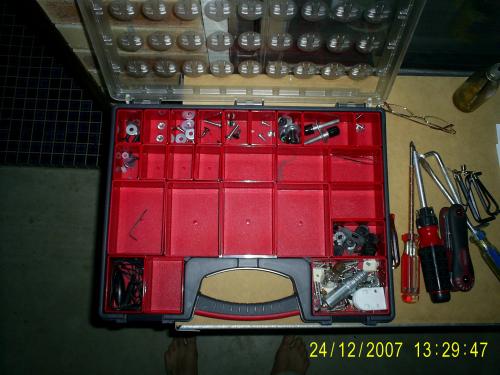
So I had the pleasure to take the rear end of the Vectrix apart in order to diagnose the problem and to replace the tail light; all part of owning a Vectrix which is probably the one furthest from the next dealer - 2000km to be quite exact, Melbourne to Gold Coast, Australia. (Correct me on this one if anyone is further away - maybe in Western Australia?)
It takes the removal of a minimum of 25 screws to replace the tail light and about one hour until the old one is out, and another hour until the new one is in and the Vectrix is in one piece again. No special tools or abilities required. Just make sure you keep all the screws in order so that there are no leftovers ;-).
Dont worry, only the two top rows of screws are from the Vectrix!
All the parts that I came across in the process appear to be well made and fit together well. It would however be an expensive job to "change a bulb" once the warranty period is over, particularly if you pay a mechanic to do the labor for you. The rear light/brake light is a semi-sealed unit with 13 LED's and a circuit board, looks expensive.
Noteworthy is that there was no warning displayed on the controls indicating that the rear light/brake light was malfunctioning; but disconnecting the number plate illumination connector causes the "position lamp telltale" to blink, and disconnecting the indicator lights causes the indicator telltales to illuminate constantly instead of blinking.
So, check that your Vectrix' rear/brake light works every now and then...
Back to the real world test ride:
I chose a stretch of road without traffic lights and a time with very little traffic - Dec 25th, 2007.
Click this link for a map of the "Test Course":
.
You get a better version of the pictures below if you click on the link above and then view it in Google earth.
.
The road winds gently uphill with a few shorter downhill stretches, probably rising about 200-300m from the start to the turnaround point on the border to NSW.
The weather was 24deg C, cloudy, a bit of drizzle at times, light to moderate wind from the south and it did not change during the test ride.
So I was starting off going uphill and against the wind, assuming that I should easily make it back to the starting point if I turned around once the battery was half empty.
I am 187cm tall, and including protective gear and all the various Gizmos I usually drag along with me, I weigh about 100kg.
The Vectrix was fully charged, then brought to the starting point (a good spot to park a trailer) in order to avoid any potential stop-and-go traffic effects on its range.
Instrument panel at the start of the test drive:
On the left: Time (13:19); Estimated remaining Range (82km); and km traveled (0).
In the middle: Total km the Vectrix has done (415.6km).
On the right: Battery charge indicator.
.
.
I kept the speed constant at 40km/h as good as I could, using the regen braking on all downhill parts of the trip.
I only stopped a few times to take photos of the cockpit; never used the disk brakes; and was as gentle on the throttle as possible.
I basically turned myself into a traffic hazard - figuring I might get away with it on Dec 25th!
The return trip is 62km long - how far do you think my Vectrix went?
.
.
Here is the instrument panel at 20.4km (uphill against the wind):
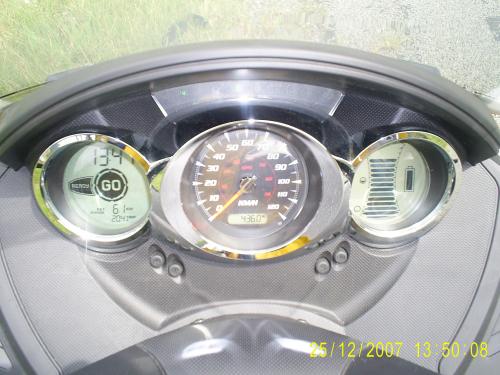
.
61km range left
20.4km traveled
13/17 bars left on the battery indicator.
.
.
Added Dec 26th, 2108h EAST:
Here is the instrument panel after 30km:
.
.
I'm sorry that it is just about impossible to read the displays on some of the photos I am showing here. It's due to the reduced picture resolution which the forum allows to upload (and my very average camera and photographic abilities....)
What you would see on the original picture is:
Time: 14:02
EST RANGE: 47km
30.0 TRIP A
445.6km total
10/17 left in battery.
.
Added on Dec 26th, 2007, 2120h AEST:
Well, I made it to the turnaround point on the test course!
.
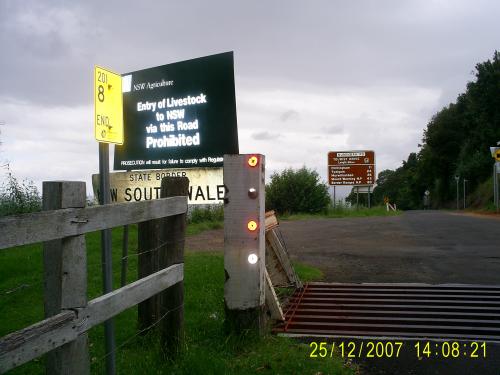
.
Instrument panel at this point:
.
Time: 14:06
Est Range: 44km
31.4 Trip A
447.0km total
9/17 remaining in battery.
.
Added on Dec 26th, 2007, 2136 AEST:
In case you wonder why I add bits at a time: It's so I don't lose hours of work when my computer plays up or if I hit the wrong button - I made that mistake yesterday :-(
Instrument panel 40.9km into the test drive:
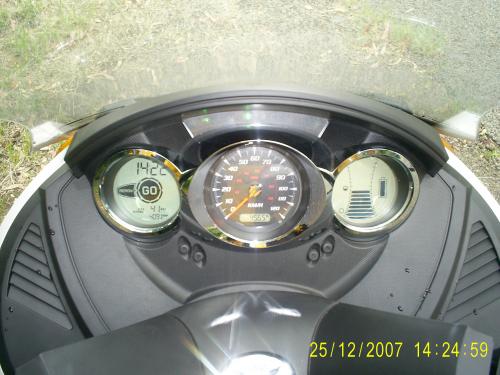
.
.
Time 14:22
EST RANGE: 41km
40.9 TRIP A
456.5km total
8/17 battery charge left.
Whats your guess - how much further will it go?
.
.
Added Dec 26th, 2007 at about 2220h AEST:
.
Instrument panel 50.3km into the test drive:
.
TIME: 14:37
EST RANGE: 33km
50.3km TRIP A
465.9km total
7/17 left in battery.
.
Added Dec 26th, 2007, about 2230 AEST:
.
Instrument panel 60km into the test drive:
.
TIME: 14:53
EST RANGE: 23km
60.0km Trip A
475.6km total
5/17 left in battery.
Still voluntarily crawling along at 40km/h....
Will it last much longer?
.
.
Added Dec 26th, 2007, about 2245 AEST:
.
.
I, and my Vectrix, made it back to the starting point! That kinda helps :-)
.
Instrument panel at 62.9km, back at the starting point:
.
TIME: 14:59
EST RANGE: 20km
62.9km TRIP A
478.5km total
4/17 left in battery.
Having made it back to the starting point I decided to start again, following a similar approach as before:
--Go at a speed of 40km/h no matter what, heading south and uphill into the wind...
and
--Turn back once half the range is gone - ie once I've traveled 10km or once the EST RANGE drops to 10km, whatever comes first.
.
How much further do you think will this Vectrix go??
Added Dec 26th, 2007, 2322h AEST:
Here is another view of the test course to help you make a guess:
.
.
Added Dec 27th, 2007, 1020h AEST:
.
I had a few minutes break before I headed off again, here is the instrument panel just before starting again:
.
Time: 15:01
EST RANGE 20km
62.9km Trip A
478.5km total
4/17 left in battery.
.
After traveling at 40km/h for 2.1km the EST RANGE indicator suddenly dropped to zero and the battery indicator did the same. It happened on one of the steeper uphill stretches.
The instrument panel at this point:
Time: 15:06
EST RANGE: 0km
65.0km TRIP A
480.6km total
0/17 Battery left.
.
More later.
.
Cheers,
Mr Mik
This information may be used entirely at your own risk.
There is always a way if there is no other way!
Good test and good test info.. I had guessed more total distance at the half way mark. I ended up way off.
Ben
http://www.hotpropertybrisbane.com
Thanks for your kind comments, Ben!
You replied to my report whilst I was typing away completing the last part of it. Now I cannot add the already typed rest to the above report.
I believe I have figured out how to compose a lengthy entry and enter it in one hit onto the website, and hope next time this will not be an issue.
So here is the last part of the report above:
I had a few minutes break before I headed off again, here is the instrument panel just before starting again:
.
Time: 15:01
EST RANGE 20km
62.9km Trip A
478.5km total
4/17 left in battery.
.
After traveling at 40km/h for 2.1km the EST RANGE indicator suddenly dropped to zero and the battery indicator did the same. It happened on one of the uphill stretches.
The instrument panel at this point:
Time: 15:06
EST RANGE: 0km
65.0km TRIP A
480.6km total
0/17 Battery left.
.
Added on Dec 27th, 2007, 2300 AEST:
.
So, of course, I turned around immediately and headed back to the starting point.
I drove very slowly and my Vectrix made it back to the starting point by itself.
Instrument panel at the end of the Range Test Drive:
TIME: 1513
EST RANGE: 0km
67.1km Trip A
482.7km total.
0/17 battery left.
So the total distance traveled was 67.1km.
.
.
.
My thoughts and comments on the Range Test:
-- it's difficult to be sure of exact tyre inflation; I will try to buy an accurate gauge for myself for future use.
See http://www.racq.com.au/images/documents/Tyre_pressure_gauge_survey.pdf for a review of the variations of tyre gauges.
-- traveling at 40km/h is not a very safe option - any bike I would consider riding regularly needs to be able to flow with the traffic and have some reserve to accelerate out of trouble.
-- the degree of roughness of the road surface might have an impact; it is certainly an issue when pedaling bicycles - I always try to stay on a smooth patch when pedaling, and the relatively rough bitumen surface on the test road might have made a difference.
-- the increased power consumption due to the drag increase in headwind might not be fully compensated for by the reduction in drag on the way back. A perfectly straight and flat test course with a smooth surface and no wind would be needed - any Vectrix owners near the Nullarbor yet?
-- increased power consumption during uphill parts of the test road will only be partially recovered during downhill parts. I have attached an altimeter to the instrument panel to document the elevation better during future tests.
-- the Vectrix is anything but silent at 40km/h - it has a whining sound much like the gearbox of a car going fast in reverse gear. It is loudest between 30-45km/h, and is not audible to me at all somewhere above 55-60km/h. I am not sure if the noise is reduced at higher speeds or if all the wind noise just covers it up.
.
And last but not least the big question to you people out there riding all sorts of electric vehicles: Is there any electric motorbike or scooter available for immediate purchase that could replicate or beat this real world test result of my Vectrix?
Please respond to this report if you regularly ride an electric bike that you believe would manage to go a similar or greater distance on the described test road.
And please report your all-time highest range result if you ride a Vectrix, so we can work out if my Vectrix is showing typical performance or is an "outlier".
.
Thanks for reading my report, hope it is helpful in some way.
.
Coming up next: Vectrix Real World Top Speed Test.
.
Cheers,
Mr Mik
This information may be used entirely at your own risk.
There is always a way if there is no other way!
Thank you for this test ride, Mik.
Another thing that may explain the missing 40km : the batteries are not trained enough.
After several discharges at 100% , you should observe an increased range.
Do you plan a range test at top speed ?
Jean-François
Yes, my XM-2000 would match this range with fresh batteries. In stock form out of the box I'm confident that my XM2K would match if not exceed that. I never did a low speed range test. However, at 40mph (65kph) it had a range of 25 miles (40km). I regularly commuted 24 miles a day at 40+mph, (that's 12 miles with a charge at work). Now there's snow on the ground and I'm back to my gas car.
I paid $1500 USD for my XM2K new. They then raised the price to $2000 USD. Unfortunately the batteries supplied are, to put it bluntly, CRAP - and now have about 10 mile range at 40+mph. Also, the wiring is marginal - the wiring is too skinny creating a large resistance drop. If one replaced the wiring (usatracy has done this) and upgraded to C-LiFePO4 batteries then I believe I would be able to handily beat the Vectrix in range tests. Both of these upgrades could be done and still come in at around 1/3rd of the $12,000 USD price of the Vectrix.
To be sure the Vectrix is a much higher quality bike. But, alas, to me it seems overpriced for what it delivers. However, seeing as they designed an electric bike from the ground up I can understand the price tag.
BTW, the XM-2000s are now sold out and are rumored to be replaced with a higher power, larger version in the spring.
Some questions for you:
1) Do you know what the specifications of the batteries in the Vectrix are?
2) Do you know what depth of discharge they run the batteries down to when the gauge reads zero?
3) Do you know how well the stock charger works?
A lot of us have learned the hard way to be wary of how the batteries and chargers are configured. For example on the XM2K "empty" is at 10.5V per battery - this gives a nice range when new but is too harsh on the batteries and greatly reduces their cycle life. Also, the batteries provided were "energy" batteries (thin plates, higher Ah's at 1C discharge rates) rather than "power" batteries (thicker plates, lower Ah's but longer life for high C discharge rates).
Good luck with your Vectrix - I look forward to reading more tests.
John H. Founder of Current Motor Company - opinions on this site belong to me; not to my employer
Remember: " 'lectric for local. diesel for distance" - JTH, Amp Bros || "No Gas.
Hi,
here is a test report of my Vectrix' Top Speed.
.
I am not keen to take photos whilst riding, you just have to trust me on the speed reports.
.
I assume the speed as indicated by the instrument panel of the Vectrix is correct; it appears to be correct when I compare it to the speed of the other traffic.
.
The test course is a stretch of the M1, click the link below to see the map:
test course
Viewing it in Google Earth gives you an even better idea of the terrain.
.
Below is a picture of the Test Course 2 viewed as if from the starting position; the terrain elevation is exaggerated x2 to make the problem more obvious:
As you can see, the difficulty is that you need to merge with traffic going at 100km/h, starting from a standstill at the intersection. And it's all going uphill quite a bit.
Then you stay on the M1 for a few hundred meters, going down the hill on the other side, cross over the M1 and merge with the M1 traffic again; at that point the terrain is almost flat, but the speed limit is 110km/h.
Then the speed limit drops to 100km/h as you approach the hilltop; continue back over the hill and off the highway, and that's the end of the test run.
It's maybe about 10km on the M1, but I did not take much note of it, it does not matter for this test setting; this one is just about top speed and acceleration.
.
So, how did it go?
The Vectrix accelerated onto the highway as if there was no hill; accelerating quickly to 102.5km/h and then suddenly the acceleration stops; merging was easy.
During merging the second time, into 110km/h traffic, the Vectrix also went 102.5km/h, although there is no climb. A speeding truck had to slow down behind me. It would be nice to be able to override the Vectrix' speed limitation on that particular on-ramp!
Here is the instrument panel after stopping to buy some velcro for attaching the altimeter to the instrument panel (to monitor elevation in future tests):
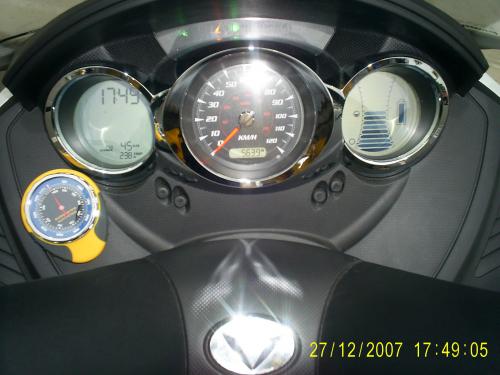
23.8km traveled, including the test course Nr 2, the rest of it also in a very throttle happy fashion at the speed limit, mostly 70 and 80km/h.
EST RANGE: 45km
Total km: 563.9
9/17 left in battery.
This is the instrument panel at the end of the trip:
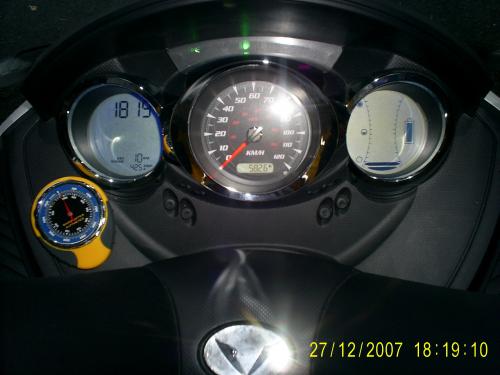
EST RANGE 10km
Trip distance: 42.5km
Total 582.6km
2/17 left in battery.
Almost the entire trip was at speeds of 70km/h or above.
The last 2 km or so were at reduced speed: 60, 40, 30km/h due to lack of power.
The range indicator did not suddenly drop to zero this time, which might be due to a change in my behaviour:
I might have figured out what causes the sudden drop to zero EST RANGE and battery power, which I observed repeatedly before:
Once power drops and speed reduces, particularly when going uphill, it is tempting to pull the throttle harder to compensate for the loss of speed. Usually this ends very soon in pulling the throttle as far as it goes and.... "PUFF", the remaining range and battery capacity is gone.
I found that if I ease off on the throttle immediately when a reduction in power becomes noticeable, and demand less than the Vectrix is able to supply, the range keeps going down slowly.
I need to test this theory further, though.
.
Summary of speed test: Excellent if no speed above 100km/h is needed. Dangerous if merging into 110km/h traffic is necessary.
I have so far not been able to find a road that the Vectrix could not climb faster than it would be safe or permitted, but I'll keep on looking.
It is very similar when there is a head wind - there is a lot of grunt left in the Vectrix at 102.5km/h, but some electronic device or software does not let it come out...
And last but not least the big question again to all you good people out there riding all sorts of electric vehicles: Is there any electric motorbike or scooter available for purchase that could replicate or beat this real world test result of my Vectrix?
Please respond to this report if you regularly ride an electric bike that you believe would manage to go a similar or greater speed on the described test road.
And please, if you ride a Vectrix and find an uphill road on which you can go full throttle without reaching 102km/h (and without killing yourself or breaking the speed limit), then let us know!
.
Thanks for reading my report, hope it is helpful in some way.
Mr Mik
This information may be used entirely at your own risk.
There is always a way if there is no other way!
Originally Submitted by Mik on Fri, 12/28/2007 - 22:26.
Photo added on Jan 6th, 2008 by Mik.
Hi again,
I need to make an important addition to the 40km/h test ride on the Vectrix.
The tyre pressure was almost certainly too low.
I do not know how much reduction in Range this might have caused.
I bought 4 different pressure gauges today and also used an electronic gauge at a petrol station.
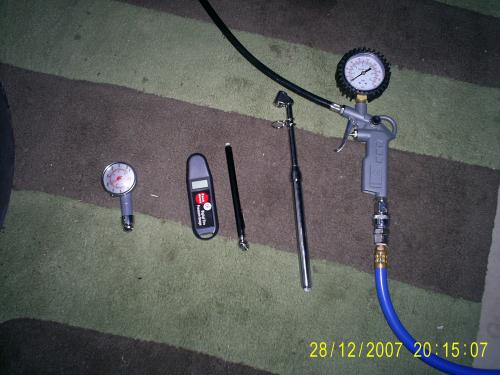
It turned out that the compressor gauge which I had used to check the tyre pressure before the test drive gives the lowest reading of them all.
The two gauges who gave the most consistent and plausible results were a small pencil type and an electronic gauge.
I am now convinced that the tyre pressure during the test ride was 27psi in the front tyre and 36psi in the rear tyre.
It should have been 32psi and 40psi, respectively.
This means that the pressure was 15.6% lower than it should have been in the front tyre, and 10% lower in the back tyre.
Again, I do not know how much -if any- range reduction this might have caused.
And I don't know if I will ever do a re-run of this low speed test. If I was to do it again, then probably very early on a Sunday morning before the wind gets up to eliminate that as an influencing factor, too.
Cheers,
from a slightly embarrassed Mr Mik
This information may be used entirely at your own risk.
There is always a way if there is no other way!
Hi mr Mik,
don't be embarrassed, your reports are most interesting, I want to buy a Vectrix as soon as I get the motorcycle license, and all hands-on experience from owners is very valuable.
Yes, tire pressure will have an impact but not enormous. From experience of fuel consumption on cars I would guess perhaps 5-10% impact in your test. To be on the safe side you could overfill some (but be careful not to exceed the max limit as printed on the tire sidewall). Also be careful to check pressure with COLD tires. As in bike parked over night and not driven one meter before measuring.
And yes, I would be interested in more reports on range, but not necessarily low-speed. At top speed or perhaps a moderate speed around 70-80 km/h would be most interesting for us, that's the kind of speed people would be doing to get long range. (40 km/h? Might as well take the bus...)
All in all, your preliminary results are a bit disappointing. I think the Vectrix people say range is 110 km at 40 km/h and around 60-70 km at top speed. Which would also seem reasonable given the weight of the bike and battery capacity. Are you sure the bike is 100% OK? What about those hills, are they just hills or rather mountains? In one documentary movie, the reporter was told that the bike needed 5 full charge/discharge cycles before full range could be expected. What are you at?
Regards,
Rolf
I'll echo a bit of what rgx said. Your reports are very interesting. I am also concerned that the range is not very close to what the manufacturer claims. On lower priced bikes some imprecision is almost expected, but for something as expensive as the Vectrix I would expect more conservative estimates from the manufacturer.
I eagerly await any more information you care to provide, Nik!
"we must be the change we wish to see in the world"
Keep in mind, the 30Ah NiMH pack it has....
I think his figures are just about right
The LiFepo4 BattMan www.falconev.com
Hi,
I have taken the opportunity -offered by some fairly miserable weather- to test the Vectrix in windy conditions.
Here is the weather map at the time of the ride:
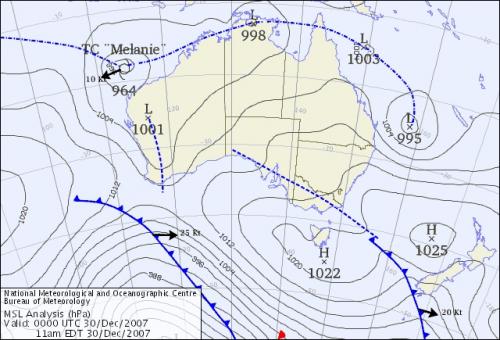
The Gold Coast is 100km north of the most easterly point of Australia.
.
And here the weather observations at the time of the ride, showing a 54km/h headwind with 67km/h gusts.
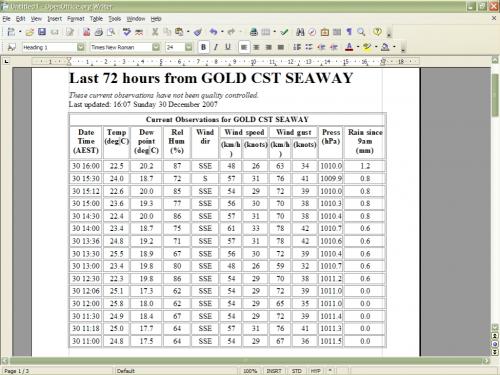
Here is a picture of the test course:

.
And here is a link to the Google map:
.
The test starts from the spot in the photo below, accelerating from zero into the strong headwind onto the highway with traffic going at about 100km/h.
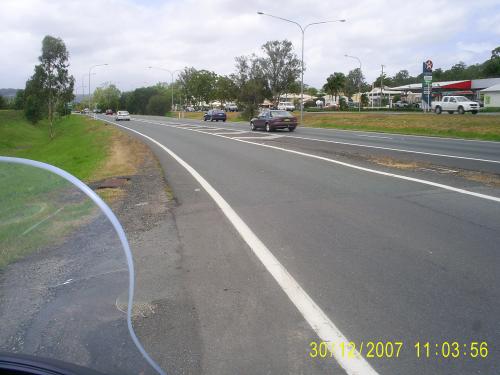
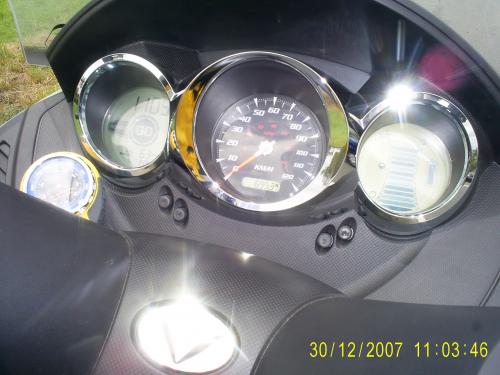
13/17 battery left.
EST RANGE: 63km.
Despite the wind the Vectrix made it to 102.5km easily before merging into the traffic.
.
The test ride then continued at 102.5km/h (sometimes a bit less due to slower cars), and sloping uphill on the part highlighted in green on the map.
Despite the combination of strong and gusty headwind with uphill slope the Vectrix continued at 102.5km/h with plenty of grunt to spare.
With "grunt to spare" I mean that the Vectrix would accelerate back up to 102.5km/h rapidly after I needed to slow down to about 95km/h due to traffic.
Instrument panel at the end of the 5km highway run:
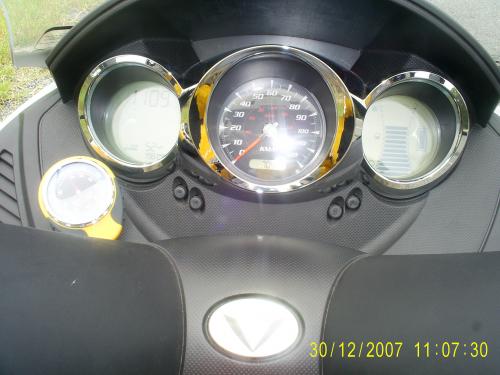
11/17 battery left.
EST RANGE: 52 km (dropped by 11km on the 5km trip).
The Vectrix felt very stable throughout the high speed part of the trip, as well as during the rest of the days riding in similar weather conditions.
It was good fun correcting for the sometimes heavy gusts coming from various angles, and I never felt that the Vectrix was getting out of control.
But if in the future there was any more wind than on that day, I would have to be desperate to get onto any bike...
So, top marks from me for my Vectrix for this sort of scenario.
.
.
Coming up: Recharging on the beach...
.
Cheers,
Mr Mik
This information may be used entirely at your own risk.
There is always a way if there is no other way!
Hi lavectrix,
I'll answer your question here as well to keep my Vectrix reports in one place.
Click here to see the original post from lavectrix: http://visforvoltage.org/forum/2616-los-angeles-vectrix-owner-questions
You manage to get much better mileage than I do, I'm still trying to work out why.
Would you mind letting us know your height and weight?
I am 187cm, 90kg, so my head and part of shoulders are in the wind when riding, maybe thats all it is.
I have been sent a map from a Vectrix rider in Tasmania who also gets better mileage than myself. The map has south at the top in case you are trying to work out where it is:
It's a bit hard to see his marks and writing on the map in the reduced size version on this forum, so here is what it says on the map;
"Sheffield Ride, 68klm @50kph, 1000ft return"
"Wilmot Ride 70klm return, 1200ft climbs, 70klms"
"Caprona Rd 65klms @ normal town speeds, flat return"
He wrote to me later:
"I get 100k/p/h to the last Klm, I regularly go to the last klm.....I fully discharge occasionally......I am 5'7" and 70kg..... am a speed freak still and ride the bike hammer down as much as any one and regularly get 55klm distance...."
.
.
.
About the headlamp output:
It's definitively less bright than car headlights, but then there is only one.
Have you ridden other bikes at night? And are their headlamps different?
The headlamp removal involves removal of the right front fairing, apparently you'll need a long philips-head screwdriver to reach a screw deep inside the fairing. Your dealer might let you have a look at the on-line repair manual that is now available to dealers, it would explain the details.
I've only replaced the rear light myself so far, see above.
It would be nice to have a brighter light for night driving if it does not reduce the range too much. The Australian Vectrix has the lights switched permanently on, so a large increase in power consumption for the lights would be a big issue. Ideal would be some sort of boost to the light output to be added only when driving at night.
Please let us know if you find a way to improve the lights!
Cheers,
Mr Mik
This information may be used entirely at your own risk.
There is always a way if there is no other way!
Thanks for the reply, Mr Mik!
As for my personal stats, I'm just over 5'10" and I weigh 180 lbs. I like long walks on the beach, and a good book by a crackling fire... (Convert the first two...)
I borrowed a Vectrix in order to do the roundtrip from work to home before deciding on my purchase, and I got almost the exact same range on the loaner as I get now. Both bikes were conditioned properly before doing the partial discharge/then full recharge that's necessary for commuting. My commute is 20 miles one-way, but considerably hillier on the way home. I live at about 1000 feet ASL and work is at sea level. I'm not a racer, but I don't ride with a range conscious approach. It takes me half a charge to get to work, and three-quarters of a charge to get home. That range works for me... so far.
What sort of range are you getting? Has Vectrix addressed this issue for you?
As for the headlight --- I just replaced the stock 35/35W lamp with a PIAA H4 Star White lamp that's rated at 60/55W, but claims an output of 110/100W. The light is much brighter, and that makes me happy. What doesn't make me happy is the fact that now my headlight icon is blinking (both high and low beam) and my taillight/brakelight doesn't work at all. I have no idea what is going on. Maybe I blew a fuse, or maybe the controller is freaked by the extra wattage. Anyone have any thoughts?
BTW, has anyone looked inside their fairing? Or under any other area of the bike that's covered by sexy plastic? When I opened up the front end to get to the headlight, I was confronted with a warren of cardboard shims and jury-rigged parts and screws that looked like it was engineered by a drywall installer. I understand we're forging new ground in transportation, and there are pains inherent with pioneering, but I'm actually wondering if this is a revolutionary vehicle or some sort of semi-scam. As for the owner's manual, it's pointless. I know this is a new product, but for eleven-grand, it'd be nice to be able to say the fit-and-finish is pretty good. Right now, I'm starting to wonder...
Has anyone invited a Vectrix representative to participate in this forum?
Hi,
this is the second part of the Vectrix Real Windy World Test Ride above.
The idea on that day was to get to Burleigh Headland to watch the huge waves created by the low pressure system hovering off the coast, sending successions of gales and showers.

What a pleasure to not be stuck in a car like the hundreds who were completely clogging up the access roads to the point break, unable to find car parks...
In the previous week I had started to take advantage of the on-board charger, using a power point provided on a public electric BBQ when it looked like I was not going to make it home without a top up.
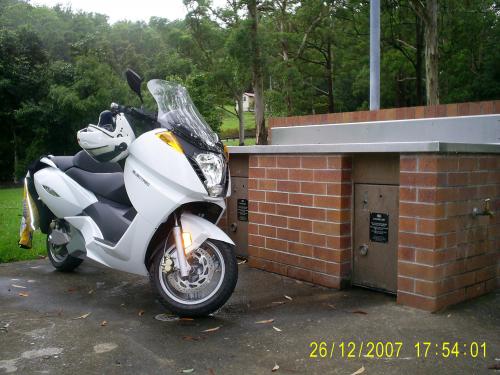
These BBQs are quite common in parts of Australia, the idea is that people will not light fires if they can just press a button and the BBQ starts heating up for free! Ergo: Less bush-fires.
Many of them around here seem to have a power point attached to them...
Because of this I expected to find a "charging station" on the beach and was not disappointed. There were several.
I carry a few bits of equipment with me (and plug them in before the Vectrix) to make sure that the power outlet is OK if I have not used it before. See the pictures below.
This device plugs into the power point and then shows if it is connected properly, earthed etc.
.
.
This device shows that the voltage is correct and can also display current, power consumption, peak power consumption etc during and after the charging process.
.
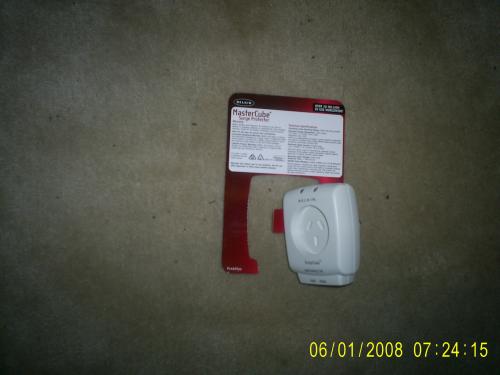
.
And this is a small surge protector - I am still not sure what sort of surge protector makes sense (if any) with a Vectrix.
This is what it looks like after some more refinement today:
You can see the Vectrix cable and plug / timer / multimeter / surge protector.
The timer is set to 7hrs to turn off the standby power consumption of my Vectrix.
.
Last week at the beach I was still using a slightly different set:
Remaining battery capacity: 7/17 (?? = 41% remaining charge??).
After checking the power point and whilst I was just starting the charging process it began to rain. Because the multimeter etc. are made for indoor use only - unlike the Vectrix - I disconnected them and plugged the Vectrix in straight. If you are sure that you have a clean power supply (steady voltage etc.) you don't need any extras anyway.
Despite the wind, salt spray and rain the charging went as usual except for lower than usual current display during the "tr" charging part.
The charging process of the Vectrix is very complex - just plug it in, go to pub, read a book (Mycelium Running by Stamets in this case, excellent)!
The charger supposedly does all the tricky stuff for you.
The left instrument shows:
00:13 (charging time)
138 (actual battery voltage)
33 deg C (temp of warmest battery cell)
The middle instrument shows:
104km/h (:10 = 10.4A DC current into batteries)
CP 150 ("Constant Power" part of charging; aiming at 150V battery voltage)
The left instrument shows: 8/17 battery capacity.
.
.
Almost two hours later:
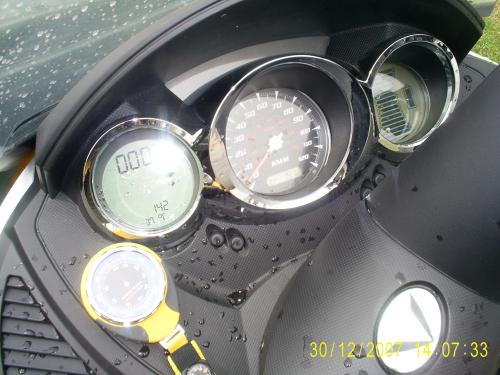
After almost 2 hrs of charging the charging cycle was "tr" for transitional or cooling.
Battery indicator shows 16/17 (?? = 94% full).
The left instrument shows:
00:02 ( 2min left in "tr" cycle)
142 (actual battery voltage)
30deg C (warmest cell)
The middle instrument shows:
4km/h = 0.4A DC (this is usually higher, about 1.6A -?? due to wind cooling on the beach??)
tr (transitional charging cycle part)
151 (Voltage aim)
The right instrument shows:
16/17 battery capacity.
.
.
After a few more minutes, and a total of 1hr 59min charging, the charge cycle had gone to the "CC" part for Constant Current:
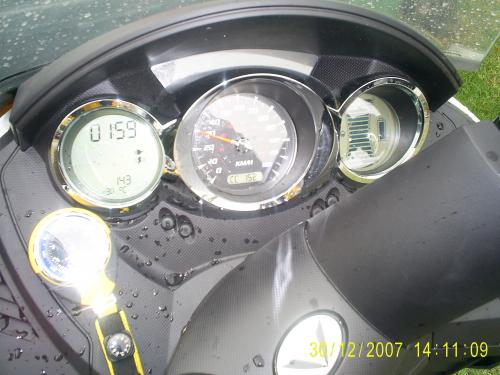
It's still only 16/17th full.
This CC charge part would usually continue for quite some time (maybe 1-2 hrs), and is then followed by the "EC" or end of charge cycle which lasts about another hour.
During the CC part the amperage seems to always be 3A, as in the photo above.
Unfortunately I know no more about the charging process than what the manual provides and what I can measure before the electrons disappear into the Vectrix.
Here is a link to the Vectrix Manual:
http://www.vectrix.com/images/Vectrix_Manuale_EN_low.pdf
So, with this very limited knowledge I calculate the recharging rate as 53% of the available battery capacity over 2 hrs for my Vectrix (94% at finish minus 41% at start).
But it can be done in wind and weather. The manual only warns against charging in standing water.
I am not sure if there are any other production scooters (or even home-made bikes) that could have been charged safely at that spot, on that day - enlighten me, please!
Cheers,
Mr Mik
This information may be used entirely at your own risk.
There is always a way if there is no other way!
Thanks for the reply, Mr Mik!
As for my personal stats, I'm just over 5'10" and I weigh 180 lbs. I like long walks on the beach, and a good book by a crackling fire... (Convert the first two...)
I borrowed a Vectrix in order to do the roundtrip from work to home before deciding on my purchase, and I got almost the exact same range on the loaner as I get now. Both bikes were conditioned properly before doing the partial discharge/then full recharge that's necessary for commuting. My commute is 20 miles one-way, but considerably hillier on the way home. I live at about 1000 feet ASL and work is at sea level. I'm not a racer, but I don't ride with a range conscious approach. It takes me half a charge to get to work, and three-quarters of a charge to get home. That range works for me... so far.
What sort of range are you getting? Has Vectrix addressed this issue for you?
As for the headlight --- I just replaced the stock 35/35W lamp with a PIAA H4 Star White lamp that's rated at 60/55W, but claims an output of 110/100W. The light is much brighter, and that makes me happy. What doesn't make me happy is the fact that now my headlight icon is blinking (both high and low beam) and my taillight/brakelight doesn't work at all. I have no idea what is going on. Maybe I blew a fuse, or maybe the controller is freaked by the extra wattage. Anyone have any thoughts?
BTW, has anyone looked inside their fairing? Or under any other area of the bike that's covered by sexy plastic? When I opened up the front end to get to the headlight, I was confronted with a warren of cardboard shims and jury-rigged parts and screws that looked like it was engineered by a drywall installer. I understand we're forging new ground in transportation, and there are pains inherent with pioneering, but I'm actually wondering if this is a revolutionary vehicle or some sort of semi-scam. As for the owner's manual, it's pointless. I know this is a new product, but for eleven-grand, it'd be nice to be able to say the fit-and-finish is pretty good. Right now, I'm starting to wonder...
Has anyone invited a Vectrix representative to participate in this forum?
Hello lavectrix,
thanks for being adventurous and trying out some things with the lights - I hope you get your tail light working again.
I might have to do a test drive with my head pulled in to find out if the mileage increases .
It looks like "the taller the rider, the lower the mileage" so far, but three reports are not really enough to blame it on that.
My commute is 38km return, about half of it at 80km/h limit, the rest 70km/h and 60km/h.
I usually have full power left when returning home, without recharging at work.
But occasionally I only just make it home, for example when it is windy and rainy and I use the brakes a lot (to keep them dry for emergency braking).
It has about 80m height difference, downhill to work and up again afterwards.
Here is a link to the Vectrix Manual: http://www.vectrix.com/images/Vectrix_Manuale_EN_low.pdf
I received a printed version of it with my Vectrix.
I had taken some of the Vectrix' front end apart when I was trying to diagnose why the tail light did not work. I did not find any problems with the fit and finish, neither with the rear end of my Vectrix. I thought that's just what good quality bikes look like, but I really never had the chance to take apart an expensive bike before.
If it was, quote: "engineered by a dry wall builder", then this wall will stay dry as far as I can see! And it will not fall apart easily, either.
Did you have to take the right fairing off to change the bulb or could you bend it a bit to get to the light bulb?
How long does it take to change the front light bulb, approximately?
Cheers,
Mr Mik
This information may be used entirely at your own risk.
There is always a way if there is no other way!
Here's a thought ...
The lighting system is probably running at 12v. To get 12v out of the back requires a DC-DC converter. DC-DC converters have a rated range, and only produce however many watts they're rated for.
You went from a 35W to 60W draw. If Vectrix designed the DC-DC converter for a power budget assuming a 35W headlight, and didn't design for much extra power draw, then perhaps the DC-DC converter is overburdened?
- David Herron, The Long Tail Pipe, davidherron.com, 7gen.com, What is Reiki
Hi,
whilst looking into the HID option mentioned by JDELUNA and miro13car, I wrote to an Australian importer of German HID lamps.

He did call me promptly the next day, and then contacted Vectrix who sent him this Headlamp Schematic (with cc to myself):
I had to turn it into a .jpg to put it on here; the original .pdf is much clearer, but it might still help someone out there somehow...
From looking at the Vectrix specs and at Philips web sites, it appears that it might be tricky to get a HID bulb that fits the Vectrix.
The Philips HS1 bulb is very different from the H1, H2 and H3 bulbs for which HID conversion kits are offered. It might be similar to H4 bulbs, but these have higher wattage (60/55W) and will probably cause the sort of problem lavectrix was describing.
Check out the bulb types here:
http://www.philipslighting.com.au/Motorcycle.htm
and here:
http://www.philipslighting.com.au/headlights.php?group=HS1
I have taken out the globe of my Vectrix to be sure what is in there, it is indeed a Philips HS1, not a HSR1 as stated in the manual (HSR1 does not exist as far as I know).
Procedure for bulb change in very short and at your own risk:
Put aside 1-2 hrs for the first time, keep parts in order, take lots of photos - you'll never know what questions you'll have when putting it back together again...
Remove black plastic grilles from each side of lamp (PZ1 bit worked best).
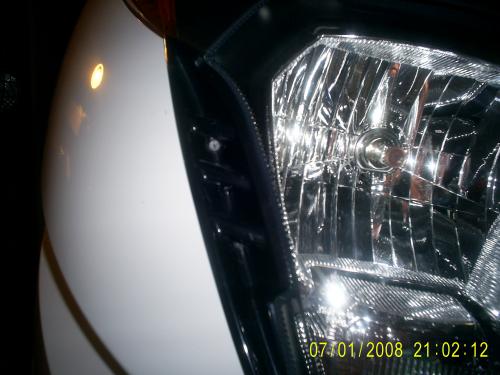
Undo screw holding R +L front fairing together just above the wheel.
Take off windscreen with metric hex key.
Do not drop the washers from underneath the windscreen -or anything else- into the fairings, it's lots of extra work getting them back! I know....

Take off black plastic cover from under windscreen.
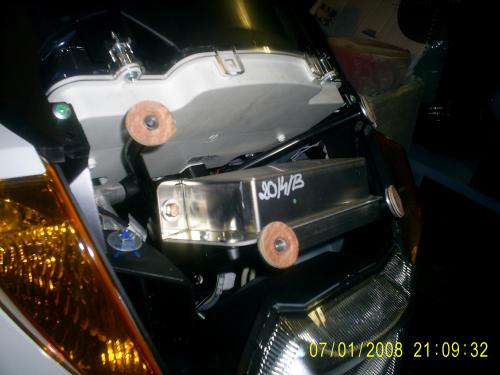
.
Undo 4 bolts holding lamp assembly.
Prize lamp out gently.
Press electric cable connector from both sides to release it and pull off.
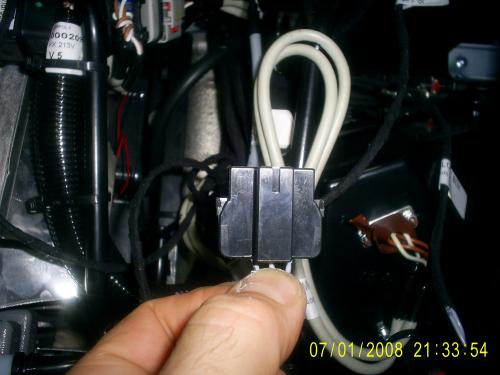
.
Disconnect parking lamp connector.
Now you can take the lamp off the bike.
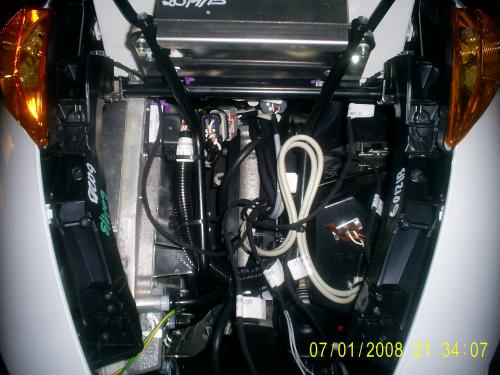
Remove rubber from back of lamp.

Remove bulb.
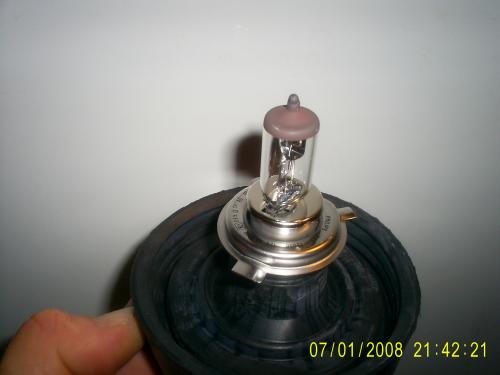
Don't do it if you have 2 left hands or don't know how to handle halogen globes.
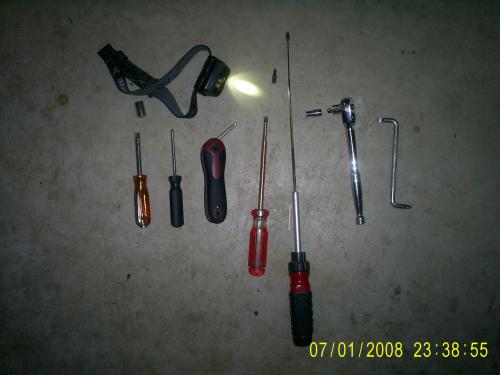
Whilst it is not rocket science to change the bulb, I would certainly not rate the job as particularly easy.
You'll also need a fair few tools, particularly if you drop anything into the fairings and don't know where exactly it is, or how to get there.
PZ1 screwdriver, angled screwdriver, extra short philips head screwdriver, magnetic pickup tool, etc., you get the picture.
This is however most likely a useless undertaking anyway, unless you have a fitting globe of 35/35W rating with higher light output than the original, or a Philips HS1 to replace a broken globe. (See lavectrix' experience with higher wattage globe...)
A few questions for Lavectrix: did your tail light start working again (I assume you might have tried to put the original globe back in)?
Did you check if the light pattern is acceptable with the stronger globe you put in, i.e. does it hit the road in the right place without blinding other traffic?
Cheers,
Mr Mik
This information may be used entirely at your own risk.
There is always a way if there is no other way!
Hi again,
the original post of this entry is here: http://visforvoltage.org/forum/2649-make-better-scooter
I posted the entry here as well because it is at least partly related to the Real World Performance of my Vectrix.
In case you feel the urge to reply, please consider to do this via the above link if that is the more appropriate forum for it.
Some good points there Andrew!
I do indeed have a lot of money, compared to the average person currently living on our suffocating planet.
But not that much that I could simply buy a Vectrix for fun. Far from it! I bought it because my calculations show that it will save me money in the short as well as in the long run.
Through my work I have the option to use a fully maintained 6cyl car, including petrol and full private use, or get an increased amount of money in each pay check and arrange for my own transport.
The first part of the calculation was really easy: It's heaps cheaper to run used cars with the payout than having the fully maintained car.
The second part of the cost analysis was more complicated, because there are many additional costs with riding motorbikes or scooters: Protective clothing, helmet, gloves, boots, security chains and locks, insurance, interest for finance.
And there are many unknowns: Will it perform as claimed, how long before the battery gives up the ghost etc.
With the perks of having a good job comes of course the responsibility to turn up reliably and on time, so the vehicle must be reliable.
And I still need to keep a car to bring a bunch of clean clothes to work every now and then, pick up family members, go surfing, etc.
Well, I concluded that there is no hope of getting the majority of people to help save the planet if the more wealthy minority is not prepared to do the right thing and take some risk with their money!
My Vectrix is not performing as well as the ads claim, but it does what I need it to do.
Well, Karma had to help me out a lot there: I got an unexpected promotion to a workplace closer to home; my Vectrix would not have made it to my old workplace and back without recharging, despite the salesman's enthusiasm...
This might however still improve if the upcoming service finds some rectifiable fault.
I am not prepared to join the traffic where I live with anything that does not have some grunt - I prefer to live! As far as I can see, the Vectrix or a car are currently the only options.
Here is part of an email I sent to my Vectrix dealer a while ago, saves me further lengthy typing (I spend way too much time writing on this forum, anyway!):
I do not believe that there is a very big market for selling Vectrix' to current petrol scooter owners; much more so for first time ever scooter buyers. This is because the running cost differential between a car and a Vectrix is so much bigger than the running cost differential between a petrol scooter and a Vectrix.
It would take some time to recoup the comparatively high purchase cost of the Vectrix when it replaces a petrol scooter.
But one would save money immediately when buying a Vectrix instead of replacing a car with a new car, even if keeping the old car registered and using it occasionally. And one gets the benefits of being stuck less in traffic and being able to find a place to park the Vectrix. Petrol scooter riders already have these advantages, and they do not face the prospect of spending $10,000.- to $40,000.- or more to replace their vehicle when it gets old.
Before purchasing my Vectrix I carefully calculated the likely costs, including everything I could think of, and came to the conclusion that it will take about 5 years to recoup the purchase price; this is including the cost to keep an old Toyota Camry, replace it every 3-4 years or so with another old car if needed, and drive it to work about once/week instead of the Vectrix. I assumed AU$1.50/l as the petrol price and AU$0.14/kWh for electricity in the calculations.
Higher petrol prices would shift the advantage rapidly towards the Vectrix option, even if electricity costs rise proportionately to petrol costs.
Of course it also depends on what the actual battery life span and servicing /repair costs for the Vectrix turn out to be over the years.
In other words, if the servicing costs etc are as advertised and fuel prices do not go up, I will own both a 5-year old Vectrix and an old car outright in 2012 without having spent any extra money compared to continuing to drive only a used car.
Since I wrote that email on 23-Dec-2007, petrol prices have already hit AU$1.50/l....chances are I'll save a packet riding electric! And thats with using the Real World Specs of my Vectrix!
And if the battery only lasts 5 years and the rest of the Vectrix also falls apart by then, I would still not have spent an extra cent.
A massively reduced environmental footprint for zero cost, and maybe even saving me money!
Oh, yes, I do also have some fun along the way!
Cheers,
Mr Mik
This information may be used entirely at your own risk.
There is always a way if there is no other way!
Hi PJD,
you wrote:
I did mention 200-300m rise in elevation, but this is of course to inaccurate.
This is why I attached an altimeter to the instrument panel for the subsequent tests rides.
It looks like this:
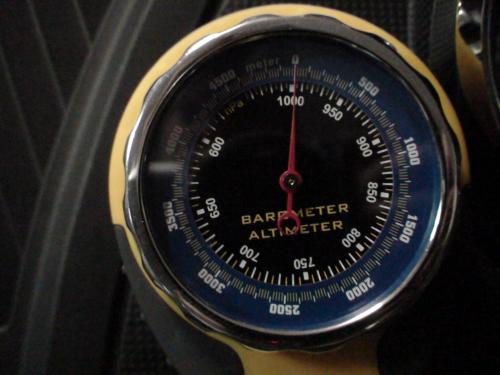
The inner scale shows barometric pressure, the outer scale shows elevation in 20m increments.
It is more often than not difficult to read in the posted photos, but allows me to record elevation along with the other data in the same photo. Because the silver metal ring on the outside can be twisted - taking the blue elevation scale with it - the elevation can be set to anything, as with any altimeter of this kind.
I have now also added a thermometer which measures air temp at the front of the bike where the battery cooling ducts start.
If you install Google Earth on your PC you can view the test route in some detail, including all the ups and downs.
As mentioned before, the tyre pressure was too low during the test ride 1 at 40km/h.
And since I have bought scales now, I have to revise the total weight carried by my Vectrix on that ride up a little bit, too: It would have been about 105kg, not 100kg.
I am hoping to go along the same route again soon, but with modifications.
Because I have found a power outlet along the way I can risk to go faster.
And I have a suspicion that the range was maybe reduced by regen braking down to 40km/h on downhill parts. Gravity is probably converting potential energy into kinetic energy and back more efficiently than the Vectrix turns it into battery capacity and back, at least at speeds below about 60km/h.
So next time I would disregard the speedo (except for staying under the speed limit) and just flow with the road and be gentle on the throttle. Who wants to go 40km/h, anyway?
Sometimes I can get a lot of extra speed for little pull on the throttle.
And I will use the regen brakes only when I have to break for safety reasons or to keep within the speed limit.
I will also lean back in chopper style to stay out of the wind. It puts a little strain on my hands, but not too much. And because the trips are never long, but the recharging is, it can be done.
Cheers,
Mr Mik
This information may be used entirely at your own risk.
There is always a way if there is no other way!
Hi,
my Vectrix died on Jan 15th, 2008 whilst traveling at 60km/h. No noise, smoke or anything, just suddenly all electricity and propulsion was gone.
Once I made it through the traffic to the side strip and had a chance to look at the instruments again, I saw a last flicker of all the lights as if the Vectrix was being turned back on, then it died, nothing at all since.
It had been standing in the open at work all day, copping a few showers, and had been driven through some drizzle and a heavy shower to work in the morning.
There was no indication of any trouble, whatsoever, before it failed completely. The battery was about half full, the remaining range was better than usual due to my "chopper style" riding position, and I was going very easy on the throttle.
It took hours for the RACQ to turn up, due to unusually high numbers of car break-downs, they said.
It figures, because the humidity was very high. We had weeks of rain, and the sun started to finally come out again, alternating with showers all day, making the sodden land steam. Temps did get to about 30degC, humidity was around 100%.
The road was actually dry and there was no rain when my Vectrix gave up the ghost.
The weather here in the last few weeks has been such that everything is constantly damp, towels never dry, showers and some ceilings or unused furniture start growing mold spontaneously, lawn mowing businesses can't keep up with the demand etc.
Tropical, in one word. But not as hot as it will get here sooner or later, only up to 30degC so far.
Well. at least my Vectrix made it past 1200km before I had to call the RACQ (Royal Automobile Club of Queensland) to tow me home ;-)
Good I still have the Camry to get to work (it does not like the wet either and is hard to start...)
I have of course let the Australian Vectrix dealer know about the problem, with cc to quality control in the USA. Apparently there is a lot of activity going on behind the scenes now, but I'm 2000km from the dealer, time will tell when the activity reaches my dead Vectrix....
I'll keep you posted...
Cheers,
Mr Mik
This information may be used entirely at your own risk.
There is always a way if there is no other way!
Mik,
Terrible news. Your experiences with the Vectrix are starting to resemble ours with the cheap Chinese scooters. I would have expected better.
Paul D.
Pittsburgh, USA
Hi,
this is a doubled-up forum entry which is also on the "How to best break in a Vectrix - Anyone's guess" forum. Comments are most welcome, but please post them at:
http://visforvoltage.org/forum/2707-how-best-break-vectrix-anyone039s-guess
That way these "Vectrix Reports" might remain more specific to actual reports.
I still hope that other Vectrix owners will join in and post some reports in this forum soon.
If you want to contribute something that is not an actual Vectrix experience or report, then please reply / comment in the other forum above.
That way there might be a chance that this forum you are reading now does not grow to an unusable size!
As mentioned above, my Vectrix recently stopped working and there is a possibility that it needs to be replaced with a new one.
I therefore think it's time to post this "Charging in the Real World Report", which I have been working on for a while.
This report should be very interesting for some people reading and writing in these forums – and extremely boring for most others. Read at your own risk ;-)
Looking through the various “V” forums makes it obvious that battery recharging is a complex process that can severely limit performance and lifespan of batteries.
The Vectrix Manual delivered with my bike was not enlightening in regards to what sort of determinants might influence the short-, medium- or long-term performance of a Vectrix and it's battery. Not at all. And the verbal advice was along the lines of " Don't worry, just plug it in when you can".
I'll try to provide details of what I observed in regards to my Vectrix' charging process here, hoping that those people amongst you with years of hands-on experience with Ev's, batteries etc. can make sense out of it, and maybe suggest how a Vectrix should be treated initially in order to maximize it's performance and battery life-span.
So please reply via the above link if you can help with suggestions.
So, finally to the charging report I was working on before my Vectrix died....
The engineers putting together the Vectrix did of course have to tackle the same difficulties as anyone else fiddling with batteries; I don’t understand this stuff sufficiently yet and can only describe what seems to be happening with my Vectrix.
I hope I am not annoying the Vectrix manufacturers by posting the observations described below. They are of course aware of these reports by now and are welcome to contribute.
I assume that the key parts of the Vectrix have been patented and described in technical terms somewhere public anyway, so I’m not giving away company secrets here.
If the descriptions here help others to improve the performance of their EV, making them a more viable alternative to fuel guzzling ICE’s, and if it helps Vectrix to improve their products further, then this post has achieved it’s purpose.
----------------------------------------------------------------------------------------
Recharging a Vectrix is apparently complex, but only for the on-board charger, which is supposed to do all the tricky things that fill the battery well and maximize the battery lifespan.
To be very clear about this, the owner does not need to do anything other than plug it in and plug it out when finished – all the apparently complicated stuff below is for the technical-minded types in these forums, who like to take things apart (particularly if they are working well) and put things together.
Only time will tell if the on–board charger does any better than a dedicated electro-geek with string-, bank-, trickle-, tickle- and who-knows-what-other-chargers and gizmos…
All the rider supposedly has to do is plug it into a standard power outlet….
I'll describe what my Vectrix seems to be doing. I do not know if others behave the same.
Also keep in mind that my Vectrix is over-due for it's first service at 1000km when you read this. The service / repair due might uncover defects that explain discrepancies between expected specs and observed real world behaviour of my Vectrix.
---------------------------------------------------------------------------------------
Well, what is the story in the real world, then?
Unfortunately it turns out that I need not only plug my Vectrix in, but also need to unplug it, and this is much more difficult then plugging it in.
Difficult because it typically needs to be done late at night.
This is because the charger / battery combo of my Vectrix consumes 0.5A * 240V = 120W of continuous power after the charging process has finished.
This causes the charger to heat up slowly, because no cooling fans are running any more once charging is over.
The heating of the charger is not obvious because it is hidden from both view and easy touch under the right front fairing. IR thermometer readings are likely incorrect due to its shiny silver surface, but the charger gets too hot to touch at times and my best guess is that its temperature reaches about 60-70 deg Celsius after several hours of sucking 120Watts at an ambient temperature of about 25degC.
I have left my Vectrix plugged in for up to 24hrs after charge completion without any apparent problems being caused by the hot charger, except to my wallet and the environment. I assume that the heating of the charger and surrounding cables etc. can only be detrimental to the overall reliability and longevity of the Vectrix, though.
Leaving it plugged in overnight increases the overall power consumption and greenhouse gas emissions of my Vectrix by at least 25%.
During the actual charging process the charger gets only slightly warm, because of the strong fans cooling it continuously.
The problem is easily fixed, though:
A timer set to 6hrs lets my Vectrix go through a complete charging cycle and then does the complicated unplugging business for me, while I sleep.
I hope this issue will be addressed by Vectrix in the future.
---------------------------------------------------------------------------------------
Another –and much less obvious – design problem is that a very small amount of pre-heated air enters the air intake vents which supply the batteries with cooling air.
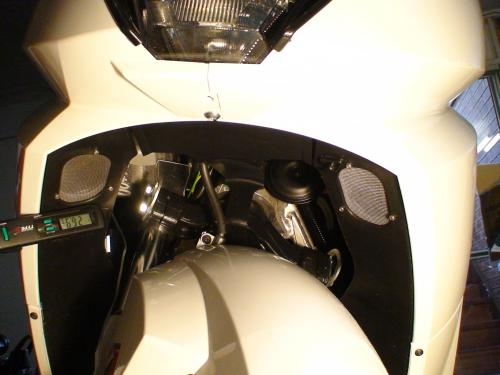
This might well be insignificant; in order to assess this fully one would have to place precision temperature probes deep inside the air ducts and ensure the cooler and warmer air parts have been mixed thoroughly before measuring their temperature. The likely temperature difference is too small to measure accurately with the sort of thermometers I have available.
The warm air comes from the charger cooling fans, which blow downward onto the front wheel cover during charging.
The two air intakes for battery cooling are located on each side above the front wheel, covered with a metal screen.
While I believe that the re-circulation of warmed air is insignificant in cool or warm conditions, it might cause problems when charging in very hot conditions.
----------------------------------------------------------------------------------------
The actual time needed to recharge is much longer than I expected.
No matter how I try to interpret the published specs, I cannot get anywhere near 80% recharge in 2 hrs.
This might be due to the current temperatures here in Australia. I was told that charging takes longer in warmer weather; the charger supposedly slows things down in order to protect the batteries from getting too hot. I think I was told that the published specs for recharging time are for 20 or 21degC ambient temperature.
The lowest ambient temps during which I could observe charging yet were about 23-24degC, the highest 28-29degC.
Assuming that the various stages of the charging process are doing something worthwhile to the battery, I try to let the charging run through the complete cycle when I can.
The recharging time from empty to full, including all stages automatically done by the charger, takes typically 5 ½ hrs and uses about 5kWh electricity.
(5h46min was the longest, 5h26min the shortest).
During the first two hours of charging about 50% of the available battery capacity is recharged.
This means 120min charging for 25 km range gain for my Vectrix, but only when the battery is more than ½ empty.
I need to charge about 4.8min for each km range I need to add when I “top up” somewhere to make it home.
If the battery is already ½ full or fuller when charging begins, then it will take longer to fill it completely than to get to 50% from empty, because during the later stages of charging the current going into the batteries is reduced.
In my experience a 80% recharge is achieved in about 3 to 3 ½ hours.
I have not done any range testing after partially charging my Vectrix.
I have not tested if the estimated range indicated by my Vectrix after partial charging, without the conditioning usually done automatically at the end of each charge, is any more or less reliable than after full cycle charging.
---------------------------------------------------------------------------------------
Here is what my Vectrix usually does when it gets plugged in to recharge:
The lights flash briefly and all instrument panel lights come on for a moment.
The throttle and all systems have their usual function disabled, making it impossible to accidentally drive off whilst plugged in. It does not matter if the key is in the "ON" position or not.
Even after completion of charging some of the usual functions of my Vectrix remain disabled, especially the ability to be driven off whilst plugged in.
If however the power is out, but the power plug is still plugged in, then my Vectrix is unable to detect this and could potentially be driven off, damaging the chord. (The power points in Australia usually have a switch next to them to turn them on or off, so this scenario is not as unlikely as it might seem!)
The instrument panel is used to display different information during charging than during driving:
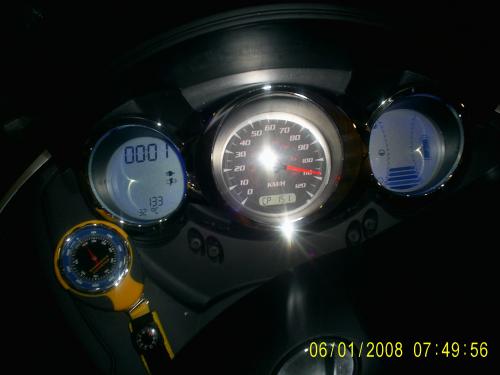
Time of day becomes charging time (00:01), EST RANGE becomes actual battery voltage (133).
Trip A/B meter becomes “temperature of the hottest battery cell” (32 degC)
Speed becomes Amp (DC) going into the battery (108km/h = 10.8A), total km becomes CP, tr, CC or EC + voltage that the charger is aiming at (CP 151)
.
The battery level indicator still shows how full the battery is, and gradually rises during the charging process. (5/17th = 29.4%)
At the same time the battery cooling fans start running, sucking in air from the R + L front fairings meshed inlets and exhausting it onto the rear wheel.
The charger cooling fans also start to run at the same time, blowing onto the front wheel as mentioned above.
Altogether this is quite noisy. The noise levels remain constant throughout the charging process.
This video gives you an idea of the noise level and of how the measurements were obtained:
At the same time that the fans begin to run the speed indicator rises to about 110km/h, which (divided by 10) tells you that the charger is putting 11A DC in to the batteries, and “CP 150” or “CP 151” or “CP 149” is displayed, for “Constant Power aiming at 150V”. I don’t know why the Voltage aim is slightly fluctuating.
---------------------------------------------------------------------------------------
The charging stages are:
CP = Constant Power; takes several hours depending on battery level.
tr = transitional ; always is 14minutes, counting backwards.
CC = Constant Current; lasts variable amount of time; speedo always shows 30km/h steady during CC.
EC = end of charge, always 59min, counting backwards.
----------------------------------------------------------------------------------------
After the end of EC the fans stop, all lights and instruments go out and the ingoing current drops to about 0.5A, fluctuating very slightly.
Just before switching off the instruments display the total charging time, and then 00:68 for a second. No idea what that means.
----------------------------------------------------------------------------------------
The battery temperature is initially always displayed as 21degC, then jumps up after about a minute, then slowly reduces by a few degrees over the next few hours whilst charging.
I cannot make much sense out of these battery temperature readings.
The initially displayed 21degC is obviously incorrect, because it is always 21degC even when the ambient temp is around 30degC and if the battery temp is around 40degC after a fast ride.
The battery temp then usually shows about 33degC after a minute or so, even if the Vectrix has been standing around for several hours or overnight to let the batteries cool down, and in an ambient temp of 24degC. I do not understand why.
After the fans have been running for a few minutes the temperature display begins to slowly drop.
The above picture was taken after a 10 hour break after driving, because I was told that letting the batteries cool down would make the charging process quicker. I wanted to test that statement. Noteworthy is that the temp of the hottest battery cell is already 32degC, despite the ambient temperature of 25degC for the last 10hrs in this example.
The following pictures have been taken later during the same charging process.
The highest battery temp I have ever seen displayed at the beginning of charging was 44degC after a fast and almost complete discharge by fast driving.
The displayed battery temp gradually reduces to somewhere in the mid- to low thirties during charging. It remains fairly stable even when the Amps are reduced during the following charging stages.
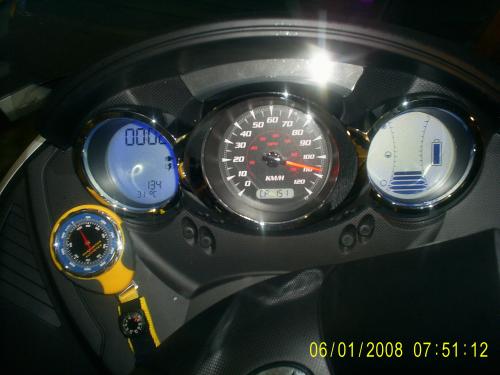
Here the displayed temp has dropped to 31degC after 2 min of charging.
---------------------------------------------------------------------------------------
I have not observed any stops or current reductions during charging due to high temp or other issues, but twice I found that my Vectrix had only charged to 15/17th when I turned it on the next morning; the charging process had stopped spontaneously for an unknown reason.
It was not hotter than usual, and there was no power outage, and it was not on the timer.
This is out of a total of 35 charges so far, in other words in about 5% of charging episodes the charger failed to automatically charge the battery to full capacity, but charged it to over 90%. It then took about two hours to let the charger run again until it stopped automatically with a full battery.
----------------------------------------------------------------------------------------
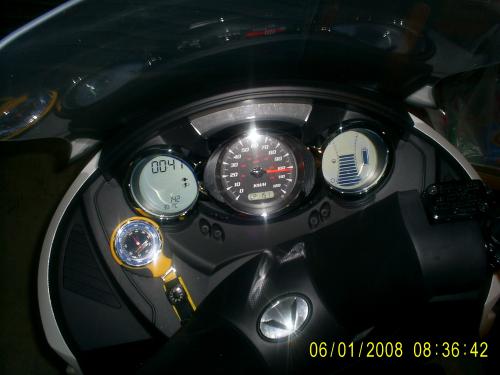
Temperature at 41min is 30degC.
During the “CP” part of charging the displayed DC Amp slowly drops from 11 to 10 Amp over several hours.
----------------------------------------------------------------------------------------
The ingoing AC power is around 1600W, with a peak at around 1700W in the first ½ hr of charging, and appears to remain stable.
It draws about 6.7A at 240V during the “CP” part, and the Amps increase if the grid Voltage drops.
My Vectrix seems to automatically draw more amps to keep the ingoing wattage constant, if the grid voltage drops. Here is a presentation on you-tube where the presenter (I don't know who he is) states that the only difference between Vectrix’ for different countries is a different plug, and that the charger automatically adjusts to different voltages. There is other interesting information relating to this report in the video as well.
----------------------------------------------------------------------------------------
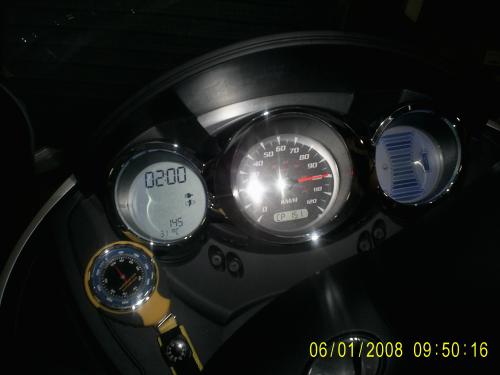
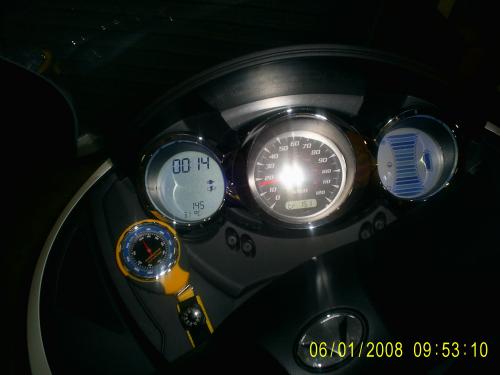
Here is a photo of the display after 2 hrs of charging - the initially missing 70% battery charge have not been completely filled up yet.
----------------------------------------------------------------------------------------
Once the battery is almost full the “tr” part of charging starts and it appears to be always 14min long. It counts backwards from 00:14.
It has the lowest current displayed (and measured going in) of all parts of the charging process, almost always 1.6A DC (=16km/h displayed) and 1.29A going in.
It is supposed to be a “transitional” period to cool the batteries before the next part, but the displayed battery temp does not usually drop during the ‘tr” part.
----------------------------------------------------------------------------------------
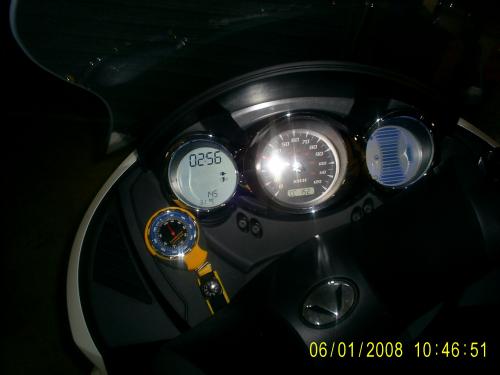
After 14min of “tr” charging the DC current goes up to 3A DC (30km/h displayed) and the km counter shows “CC 152” for “Constant Current aiming at 152V”.
This can last several hours.
It draws about 2.06A at 240V = 494W during the CC part.
Looking through my photo records I just noticed that the "tr" can be followed by another "CP" cycle, then another "tr"; this happened on one of the occasions when my Vectrix did not spontaneously reach 100% full battery through the automatic charging process, and needed another 2.5hrs top-up the next morning to reach the end of the charge cycle.
----------------------------------------------------------------------------------------
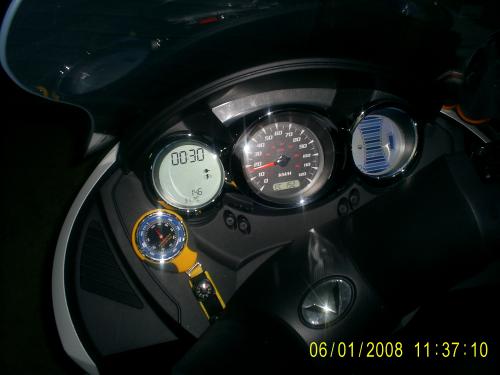
Finally there is a “EC” part for “End of Charge” which counts down from 59min to zero.
It draws about the same amount of power as the "tr" part, probably just cooling the batteries, not sure.
----------------------------------------------------------------------------------------
Overall 4.2kWh were used in this charging process. 1747kWh was the peak power consumption about 13min after the start of charging.
----------------------------------------------------------------------------------------
At the end of charging my Vectrix briefly displays the total charging time again, followed by “00:68” for one second, then all lights and fans go out and the charger starts to slowly heat up as described above.
I do not know what 00:68 means, but it is there each time I happen to be watching at the end of charging.
In Summary:
It takes about 5 and a half hours to fully charge empty batteries.
Uses about 5kWh for a full recharge.
Apparently it conditions / differentially charges cells.
Very easy and reliable 95% of time.
Partial charging / opportunistic charging is apparently OK.
Noisy due to multiple fans running.
Takes longer than advertised.
Standby power wastage.
Please let us know (at http://visforvoltage.org/forum/2707-how-best-break-vectrix-anyone039s-guess) if you have any ideas how to best "condition" or "break in" the battery on a new Vectrix. It's supposed to be a 40Ah NiMH battery, I believe.
--------------------
Cheers,
Mr. Mik
This information may be used entirely at your own risk.
There is always a way if there is no other way!
Hi,
here is a video recorded a while before my Vectrix died.
It shows the instruments of my Vectrix accelerating from zero to 100km/h, then decelerating with full regen throttle applied.
It's done with 111kg ballast on board, including the lot.
It can sometimes be difficult to be sure if it is really completely flat, but it was close to flat.
The acceleration time I measured using this video lies smack-bang in the middle between the measurements obtained from other videos, which were done on a piece of road with a slight slope; and done in each direction. I believe that means that the road this video here was made on is very close to flat.
There was very little wind.
My Vectrix is currently still out of order, waiting for a thorough service and repair; the acceleration may be different for other bikes.
Mr. Mik, ............. Toyota Camry :(
This information may be used entirely at your own risk.
There is always a way if there is no other way!
Here are some photos documenting what effect regenerative braking can have under favorable conditions.
The first photo shows my Vectrix’ instruments on top of a long, downhill road.
Estimated range left: 28km
Trip A distance: 31.9km
.
.
The second photo was taken after rolling down the hill, Estimated Range now 29km, Trip A 38.1km.
So the downhill trip was 6.2km long and the Estimated Range increased by 1km instead of dropping.
.
Whilst rolling downhill I used only regenerative braking where needed to stay under the 60km/h speed limit, and did not use the motor for any propulsion. At one stage, on a flat stretch, my Vectrix almost came to a halt but then slowly picked up speed again.
The two pictures were taken 13min apart and I would have taken about 1 min for packing away the camera etc, which means the average speed down the hill was about 31km/h.
I guess that using the motor just a little bit here and there might have actually resulted in a bigger range increase than only rolling, because it was quite slow at times, and the lights, electronics and cooling fans were all running, using up some of the battery charge.
My Vectrix is currently still waiting to be repaired.
Once I have a running Vectrix again I might try to drive this test course with and then without regenerative braking under otherwise similar conditions. This should then cancel out the effect of battery drain from lights and fans and electronics being on, and determine how much range the regenerative brake actually adds under these conditions.
Mr. Mik
This information may be used entirely at your own risk.
There is always a way if there is no other way!
This test also starts at the top of a steep downhill test run:
3.9 km downhill, 350m height difference.
Motor used gently for about 1km to get bike to 80km/h on the last, less steep part.
Photo 1:
51km Est Range ;
15.8km Trip A ;
400m elevation.
.
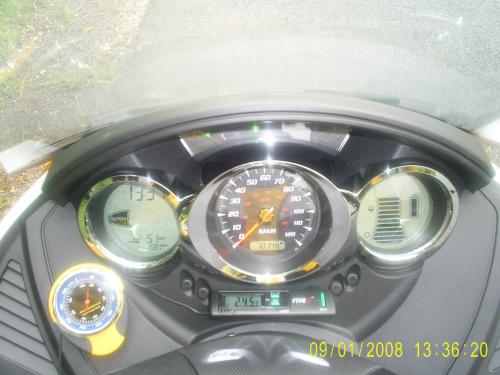
.
..........................................................................................
Photo 2:
54km Est Range ;
19.7km Trip A ;
50m elevation.
.
.
.
What I think it means is:
A 3.9km downhill run with an average 11% slope adds 3km to the range rather than dropping the range.
My estimate is that the range would have dropped by between 1 and 3 km without regenerative braking, but this needs to be tested by using the disk brakes only on this trip once my Vectrix is running again (or has been replaced).
Only a minority of commuters will have this sort of steep climb or descent included in their regular route, and usually they will drive down the mountain to get to work while the battery is full anyway.
But I arrived home on that day with Est Range 21km left, which usually meant pretty much empty for my Vectrix, and so the regen braking saved me from having to push several km!
Of course, if my Vectrix had been capable of achieving the advertised specs for range, then I would have had battery charge to spare coming home, anyway!.
I’m still hopeful that a thorough service and repair will find some rectifiable cause for the range problems (and get my Vectrix going again), or that a replacement Vectrix performs better in regards to range.
.
Mr. Mik
This information may be used entirely at your own risk.
There is always a way if there is no other way!
Pages